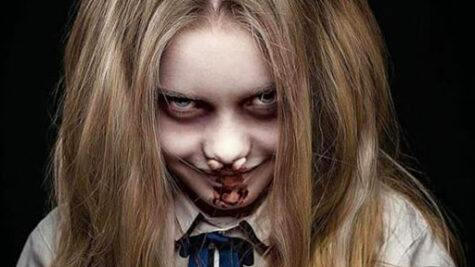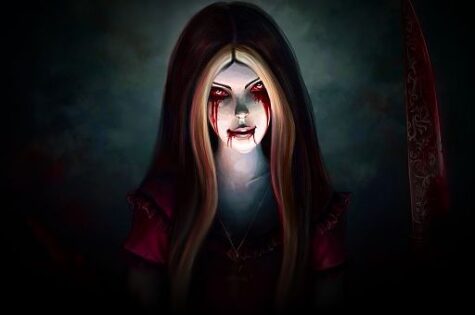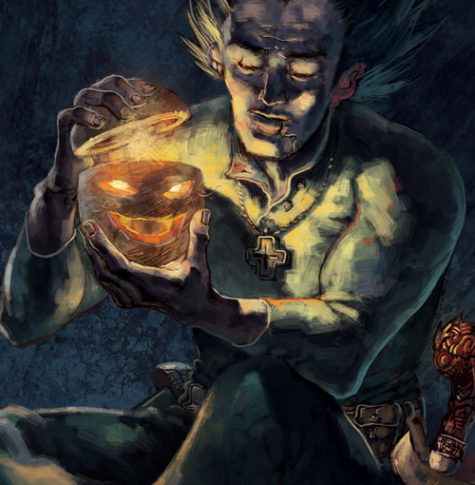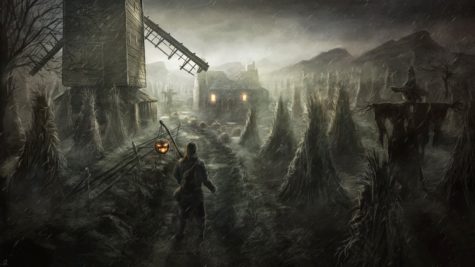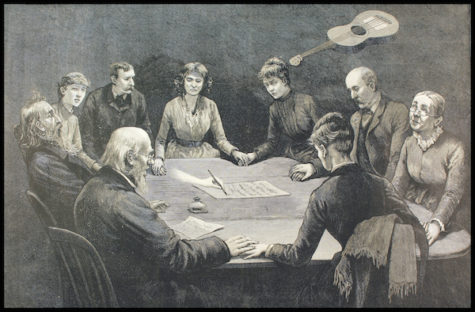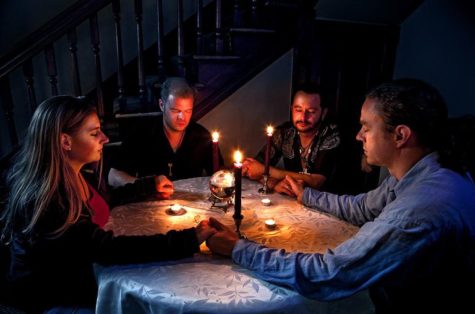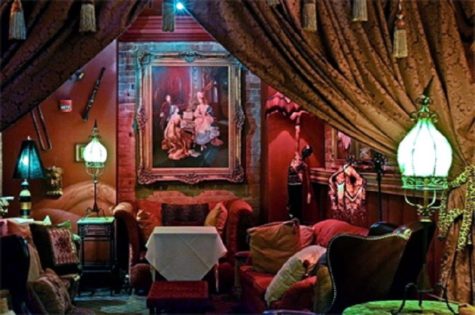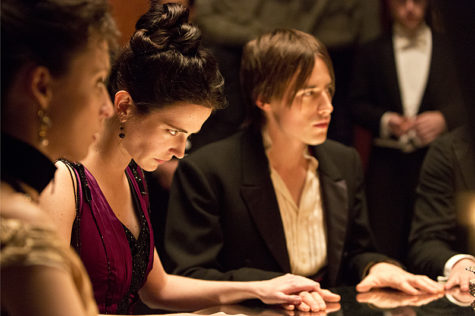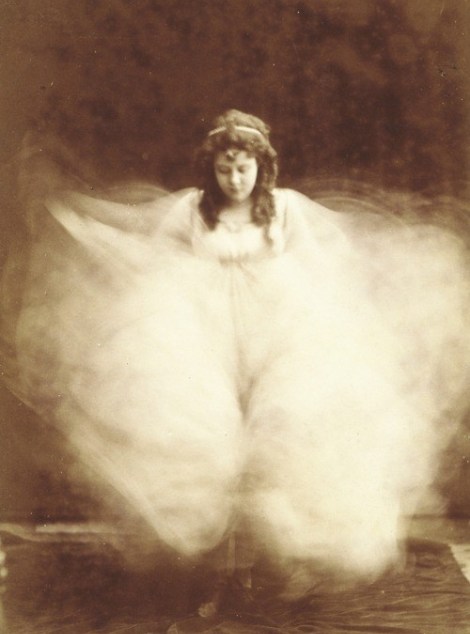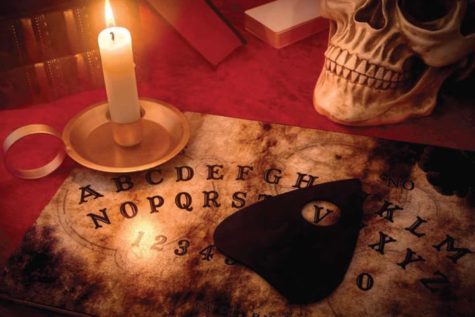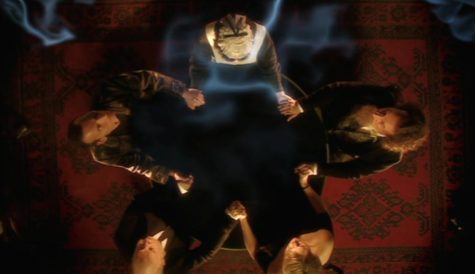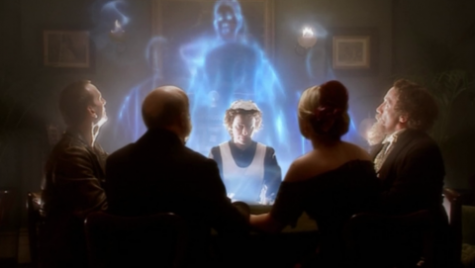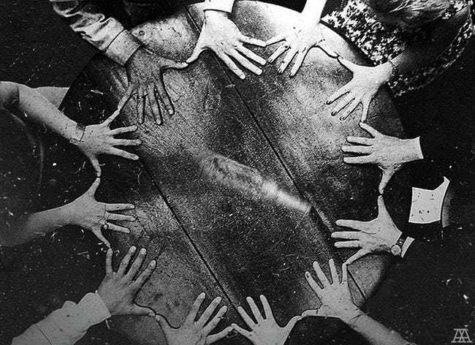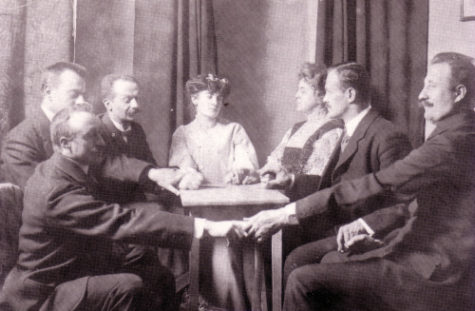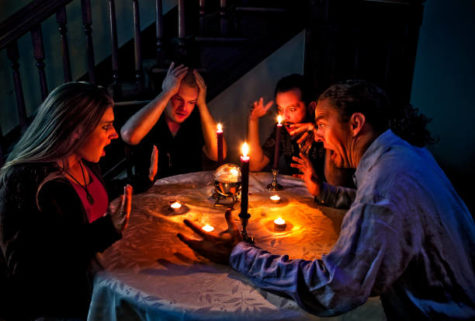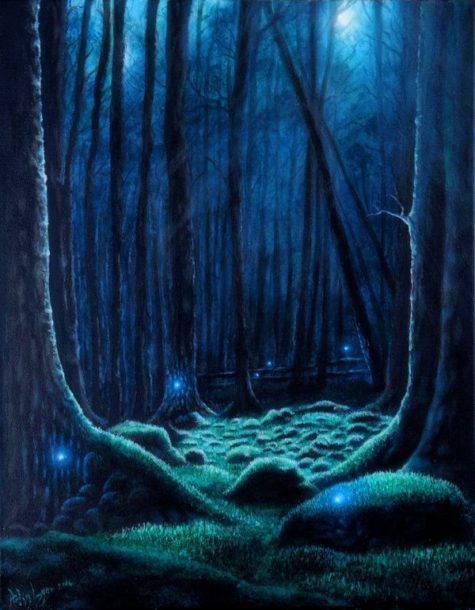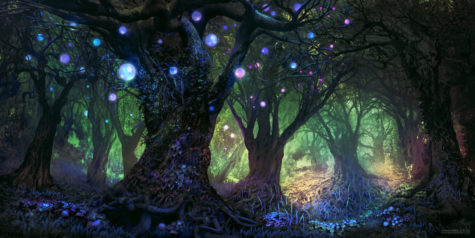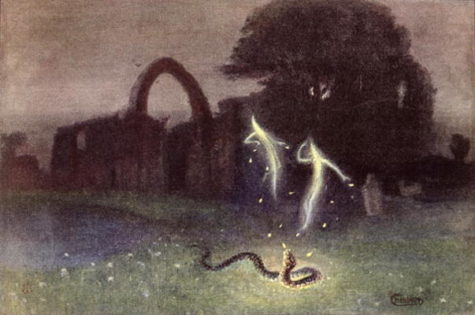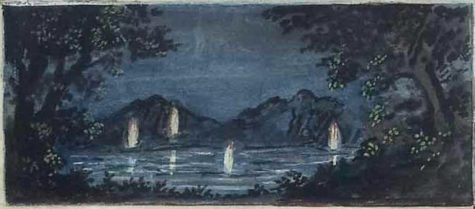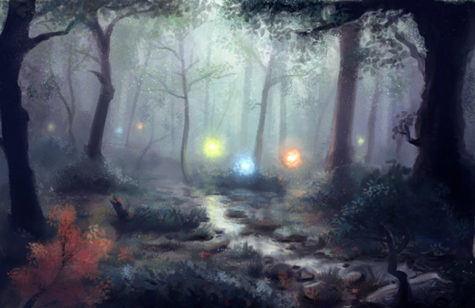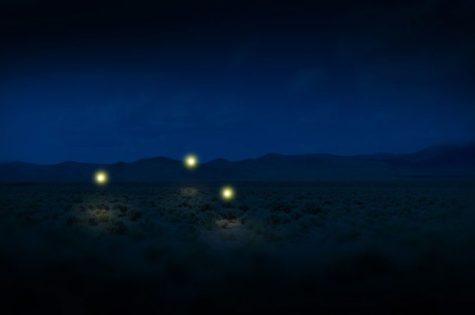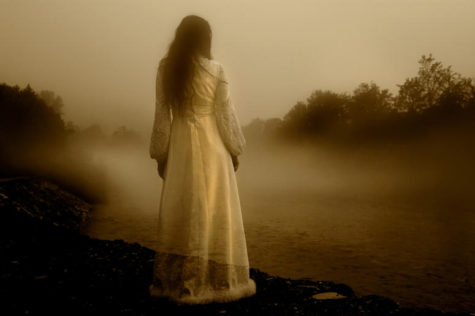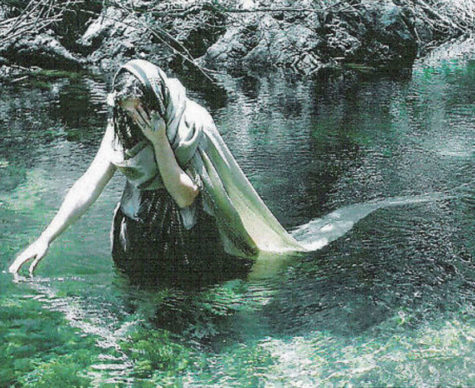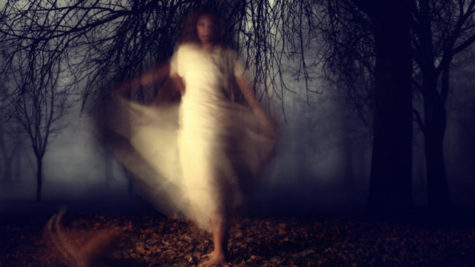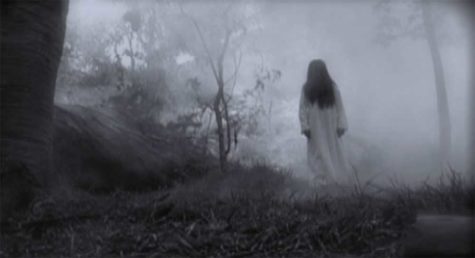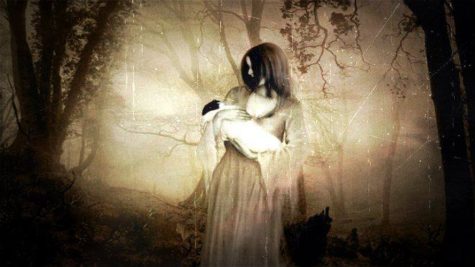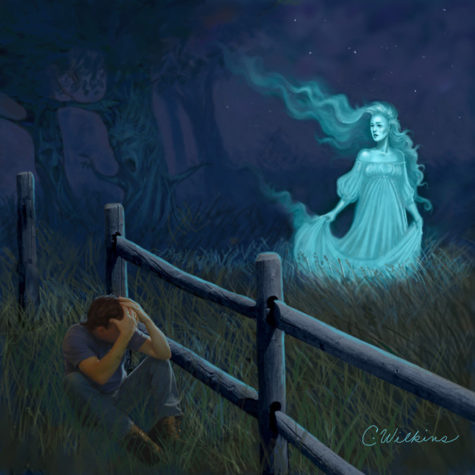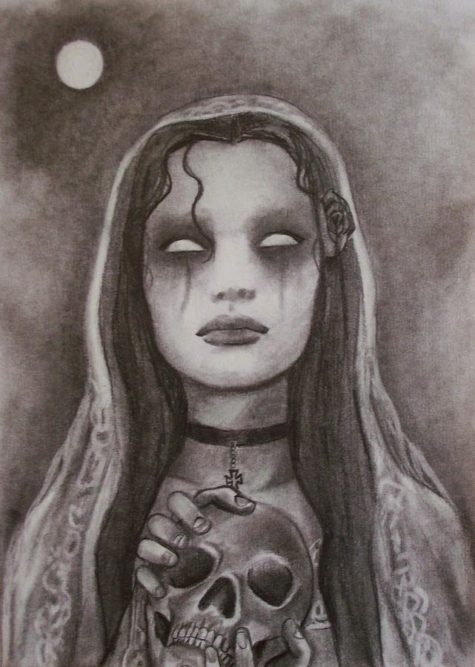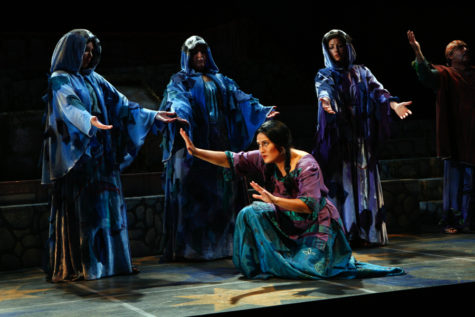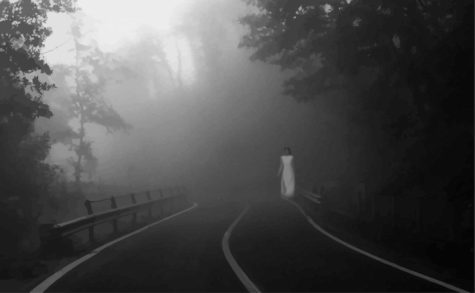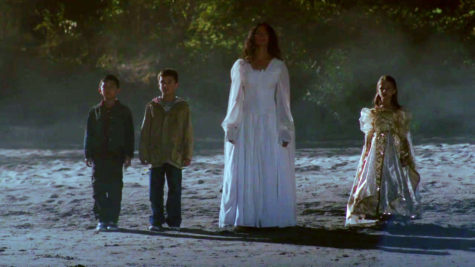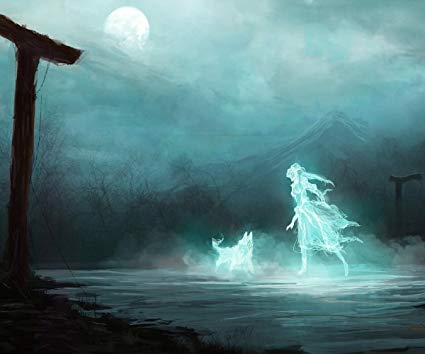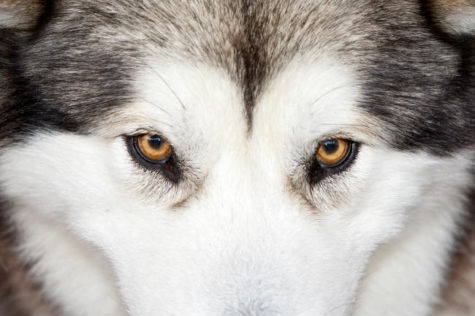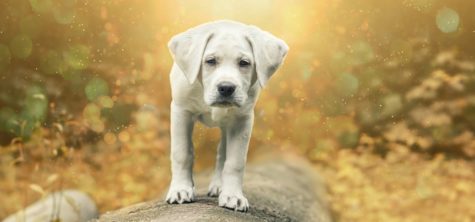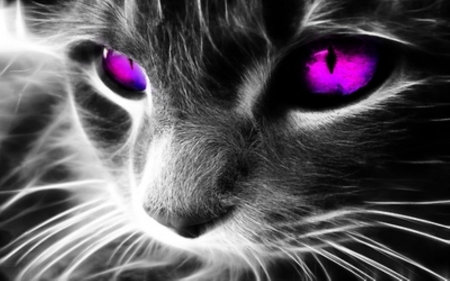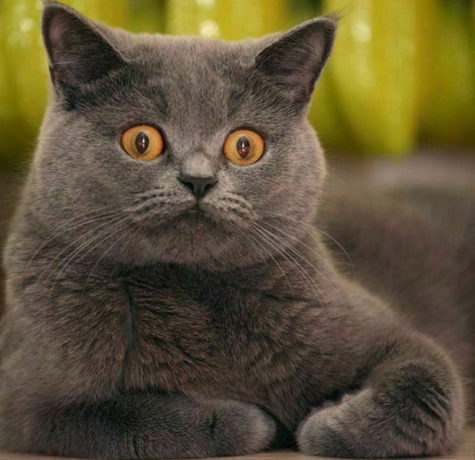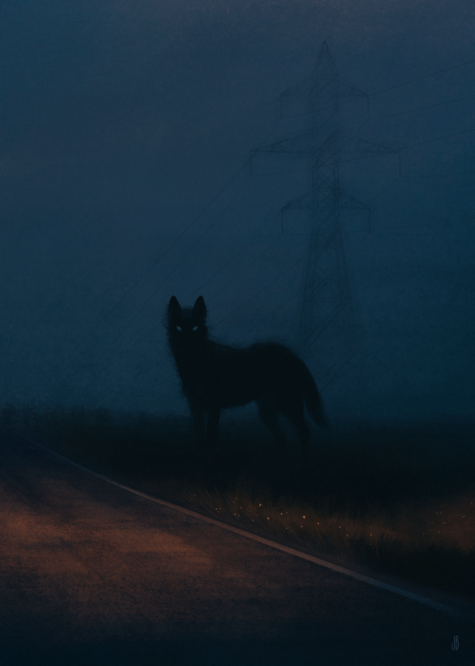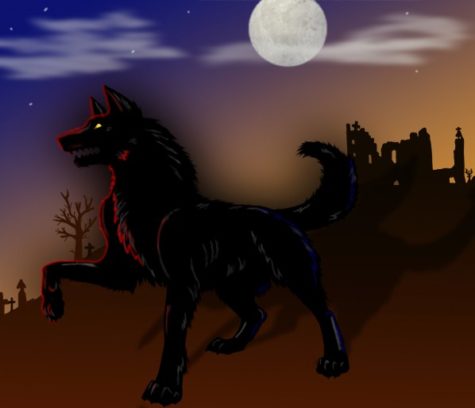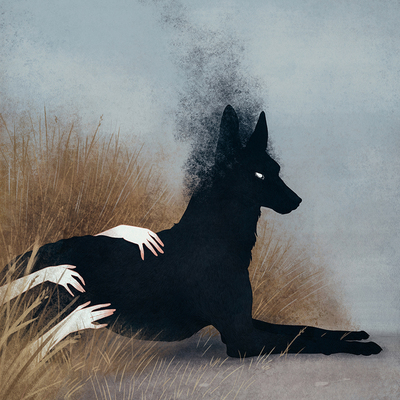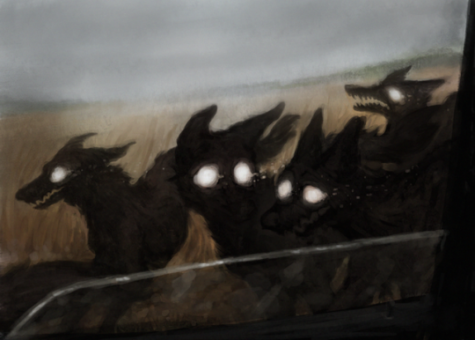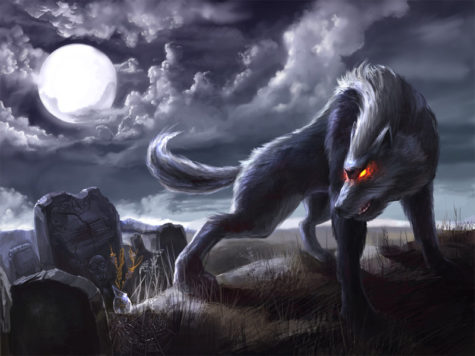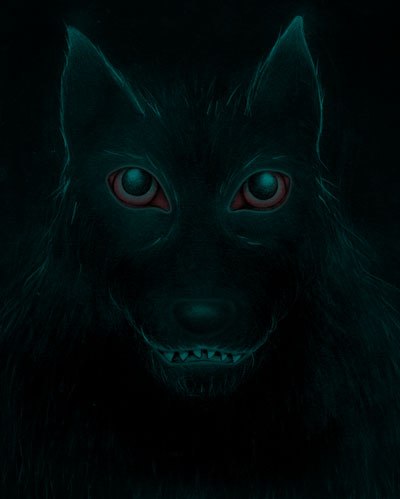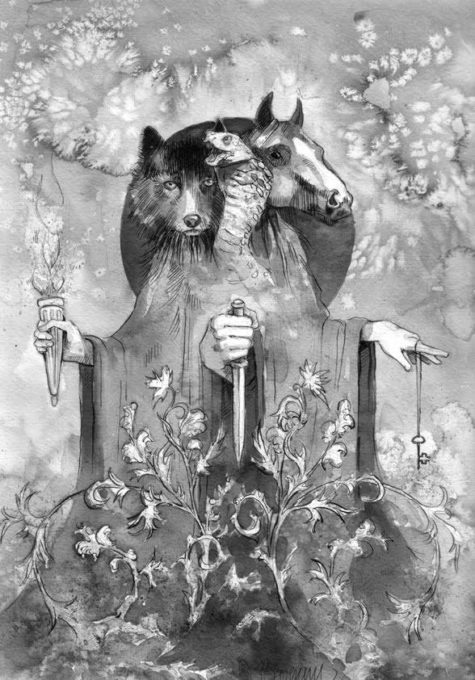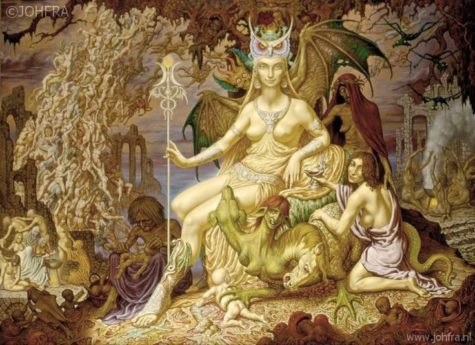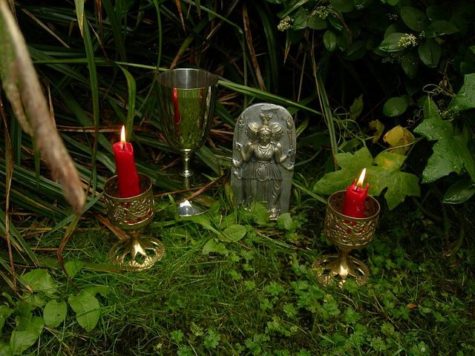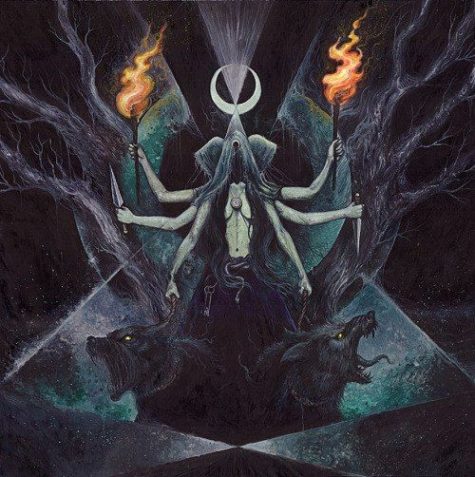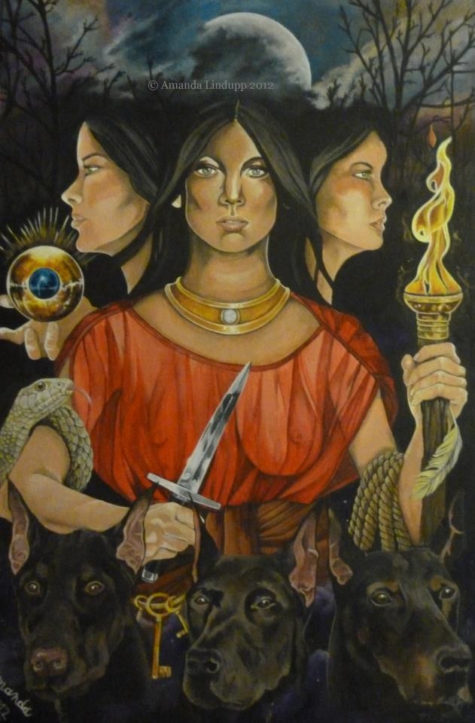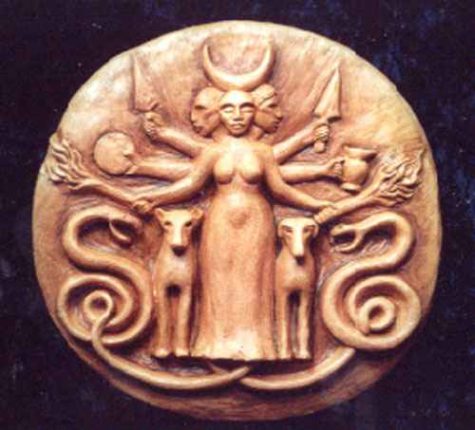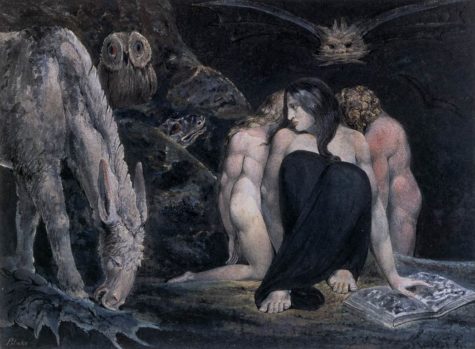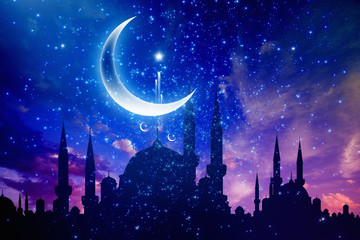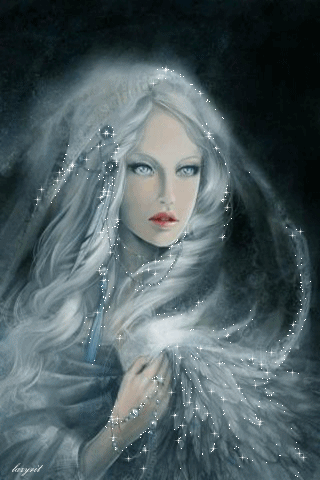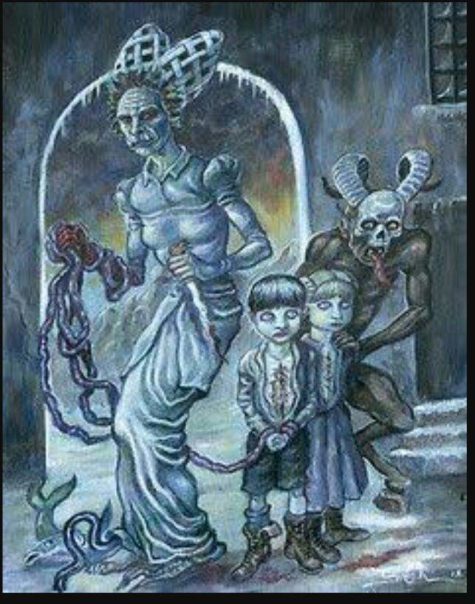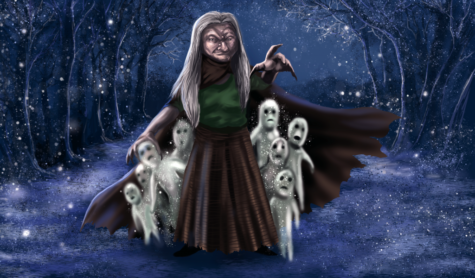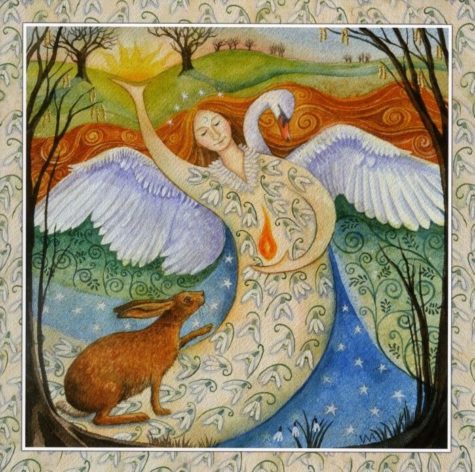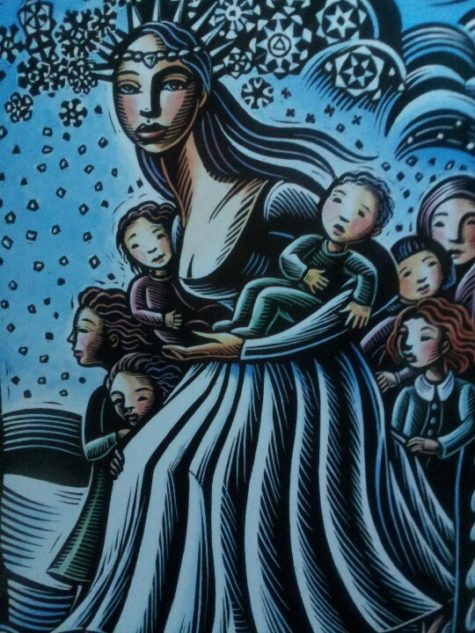Ghosts
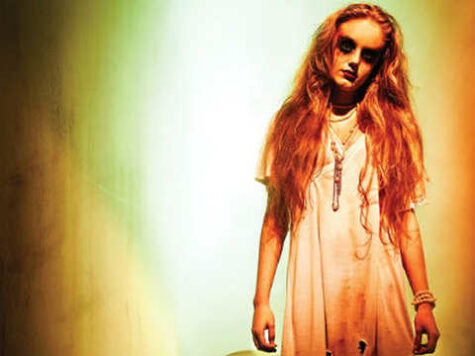
Brazil has its fair share of urban legends, some of them terrifying. Take the legend of the Loira do Banheiro (the bathroom blonde), for instance. This legend tells the tale of an amazingly beautiful girl with long blonde hair who killed herself (or was killed) in a bathroom.
In some stories, she is a bride ghost who lives inside the last stall of every public bathroom. Her soul is trapped there, and she must spend the rest of eternity scaring the crap out of people who show up to do their business.
There are other blonde woman legends as well, including one that involves a blonde on the street who tricks men into giving her a lift, then tries to murder them.
Popular Versions of the Loira do Banheiro Story:
They say she is the ghost of a dead girl with long blond hair. Her nose and mouth are stuffed with bloody cotton, blood streams from her empty eye sockets and her skin is covered in small cuts. Some say she appears in the mirror and stares at you and others say she asks you to take the cotton out of her nose.
To make her appear, you must go to the last stall in the bathroom and kick the door 3 times, flush the toilet 3 times, turn a tap on and off 3 times and say a curse word out loud 3 times.
According to this legend, she was once a beautiful blonde girl who always skipped classes and hung out in the school bathroom, smoking, drinking alcohol and generally getting up to no good. Then one day, during these escapades, she slipped on the wet bathroom floor and hit her head on a toilet and bled to death.
Not satisfied with her premature and tragic end, her soul would not rest in peace, and since that day, the toilets of schools are haunted by the spirit of the dead blonde.
In another legend, her name was Maria Augusta and she was the daughter of a Brazilian viscount. At the tender age of 14, her parents forced her to marry a man she didn’t love. He was also much older than her and she was very unhappy in the marriage.
She ended up having an affair with another man and she ran away to Europe with her lover. Unfortunately she died of pneumonia and her remains were shipped back to her parents. They say that at the exact moment of her death, a mirror in her parents house shattered. Her parents put her body on display in a glass case and refused to bury her.
There is yet another legend that claims the blonde in the bathroom was once a teacher who fell in love with one of her students. When her husband found out, he flew into a jealous rage and murdered her.
First he stabbed her and sliced her face to ribbons, then he stuffed her head down one of the school toilets until she drowned.
An Eyewitness Account:
It all started when this girl in my class started reading about urban legends on the internet and found the famous legend of the blonde in the bathroom. She told all of us that she was going to do the ritual. She did everything right and she was alone in the bathroom with the door locked. I don’t know what happened while she was alone in there, but when she came out she acted like nothing had happened.
When we asked her if the ritual worked, she was like, “What are you talking about?” She couldn’t remember anything about it. When one of my friends mentioned something about the blonde in the bathroom, the girl suddenly began to bang her head on the table, her eyes turned back in her head and she gave a horrible screech. Her parents had to come and take her home. When she came back to school a few days later, she said, “I don’t know, I do not remember anything!”
Another Eyewitness Account:
When I was little I was always fascinated by the supernatural. One day my friend and I were in school when we heard someone screaming from the second floor. We ran up there and what we saw was incredible.
We saw many people gathered around the door of the bathroom and just as we were going to see what was going on, we saw a student running scared and crying. There was a woman following her with a bloody nose, bloody face, and her skin was all torn and bleeding. Most importantly, she was blonde.
After a while, we saw two nuns coming and the blonde ran into the bathroom. When the nuns opened the door, the bathroom was empty. She disappeared. To this day, I can still remember that face.
Sources:
The Jack-o’-lantern is carried by a drunkard named Jack. Jack sold his soul to the devil, so that the devil would pay his pub tab. When the devil returned from the pub to collect Jack’s soul, the man tricked him into climbing a tree, then drew a cross under the tree, trapping the furious devil in its branches. Later, when Jack died and was rejected at heaven’s gates, he had to beg the devil for a place in hell. The devil was delighted at his chance to get revenge. He cursed Jack to wander the earth, with only a small frame for light. Jack put this flame in a carved turnip and used it as a lantern.
The Ignisfatus, or exhalation termed “Will-with-a-Whisp,” or “Jack-with-a-Lanthorn,” which is sometimes seen in churchyards, or marshy and fenny places in summer and autumn, was considered by many old inhabitants in this neighborhood, when the author was in his infancy, to be a kind of device of the evil spirit to draw human beings from the road they were pursuing into some frightful abyss of misery; and there leave them without any hope of regaining the enjoyment of happiness in the land of the living.
Stories of the origins of the jack o’ lantern are many and varied. Here are some of the ones I found:
- A Stupid Devil
A popular legend giving the origin of the jack-o’-lantern in Wales deals with the idea of a stupid devil. A long time ago there lived on the hills of Arfon an old man of the name of Sion Dafydd, who used to converse much with one of the children of the bottomless pit.
One morning Sion was on his way to Llanfair-Fechan, carrying a flail on his shoulder, for he had corn there, when whom should he meet but his old friend from the pit, with a bag on his back, and in it two little devils like himself. After conversing for some time they began to quarrel, and presently were in the midst of a terrible fight. Sion fell to basting the devils with his flail, until the bag containing the two little ones went all to pieces, and the two tumbling out, fled for their lives to Rhiwgyfylchi, which village is considered to this day a very wicked place from this fact.
Sion then went his way rejoicing, and did not for a long time encounter his adversary. Eventually, however, they met, and this time Sion had his gun on his shoulder.
“What’s that long thing you’re carrying?” inquired the devil.
“That’s my pipe,” said Sion.
Then the devil asked, “Shall I have a whiff out of it?”
“You shall,” was Sion’s reply, and he placed the mouth of his gun in the devil’s throat and drew the trigger. Well; that was the loudest report from a gun that was ever heard on this earth.
“Ach! – tw! – tw!” exclaimed the smoker, “your pipe is very foul,” and he disappeared in a flame.
After a lapse of time, Sion met him again in the guise of a gentleman, but the Welshman knew it was the tempter. This time he made a bargain for which he was ever afterwards sorry, i.e., he sold himself to the devil for a sum down, but with the understanding that whenever he could cling to something the devil should not then control him.
One day when Sion was busily gardening, the evil one snatched him away into the air without warning, and Sion was about giving up all hopes of again returning to earth, when he thought to himself, “I’ll ask the devil one last favor.”
The stupid devil listened.
“All I want is an apple,” said Sion, “to moisten my lips a bit down below; let me go to the top of my apple tree, and I’ll pick one.”
“Is that all?” quoth the devil, and consented.
Of course Sion laid hold of the apple tree, and hung on. The devil had to leave him there. But the old reprobate was too wicked for heaven, and the devil having failed to take him to the other place, he was turned into a fairy, and is now the jack-o’- lantern.
- The Welsh Story of Lantern Jack
This is one of the apparitions of the night, and one of the most mischievous and tricky of the ghostly family. What form or color he has we know not, as no one has ever clearly seen him; his lantern has been seen, and he has been heard splitting his sides with laughter at his own tricks, and the perplexity of those whom he might have led astray; and people say that his laugh was not unlike the loud sudden neighing of a horse.
His light was seen on dark nights like a lighted lantern on the sheep-paths on the hillsides. If he happened to be far off, no one was deceived, as his ungainly movements betrayed him as “Lantern Jack in search of his sheep,” and as the saying goes:
An ignis fatuus
Deceives not many of us.
The time when he generally succeeded with his mischief was when he found someone all alone travelling a path on open fields. He would begin by appearing as a small speck of fire, of a clear blue flame, which he moved before the wayfarer along the middle of the path until his attention had been secured; then the flame would gradually grow until its brightness would completely blind him, after which the traveler was entirely at Jack’s mercy, and he would lead him where he pleased.
Stories are related of men who have been led miles out of their way in this manner, especially young men going to see their sweethearts on dark winter nights.
- The Spirits of Unrighteous Men
Jack o’ lanterns are the spirits of unrighteous men, which by a false glimmer seek to mislead the traveler, and to decoy him into bogs and moors. The best safeguard against them, when they appear, is to turn one’s cap inside out.
When any one sees a Jack o’ lantern, let him take care not to point at him, for he will come if pointed at. It is also said that if any one calls him, he will come and light him who called; but then let him be very cautious.
Near Skovby on the isle of Falster there are many Jack o’ lanterns. The peasants say they are the souls of land-measurers who in their lifetime had perpetrated injustice in their measurements, and therefore run up Skovby bakke at midnight, which they measure with red hot iron rods, crying, “Here is the clear and right boundary! from here to there!”
- Another Jack o’ Lantern Story
There is, however, another story as to the origin of the jack o’ lantern. The haunting spirit is that of a blacksmith, who could get no admittance even into hell. He was very cold, and begged for a single ember to warm himself, and at last one was given him, and he has gone shivering about with it ever since.
- Jack o’ Lanterns Baptized
Jack o’ Lanterns are, as tradition tells us, the souls of unbaptized children. Because these souls cannot enter heaven, they take their abode in forests, and in dark and desert places, where they mourn over their hard lot. If at night they get sight of any person, they run up to him, and then hasten on before him, to show him the way to some water, that he may baptize them therewith. And that no one should neglect to do, because the poor beings must remain without the gates of paradise until some one takes pity on them.
Sources:
Throughout the Victorian age, parties that featured a séance were all the rage. Hosts would gather people together to contact the dead. In recent years, there has been increased skepticism towards séances. However, a lot of people continue to believe that making contact with the dead is possible.
Hosting a séance can be an emotional, yet satisfying experience. When hosting your meeting, proceed with caution and patience to get the best results.
If you decide to try to conduct a séance at home, expect some awkwardness, especially on your first try. I’ve always thought that beginner’s séances were like a scene in a movie about teenagers away at summer camp, where the girls and boys from across the lake are thrown together for a one-night dance. In a séance, of course, it’s not about overcoming the gender divide, but the gap between the living and the dead. Like hapless teens, there’s a lot of hesitancy on both sides, and communication doesn’t always come easy—especially considering the dead don’t usually have audible voices!
Supplies and Necessities:
If you’re planning to hold a séance in your own home, you need a few like-minded people and a few vital supplies.
- Choose good company.
A séance generally requires a minimum of three people; one to be the medium, who contacts and channels the spirits, and at least two others to provide supportive energy. Make sure you choose friends who are respectful, comfortable with the supernatural, and focused—your friend who can’t stop fidgeting with his phone in a movie theater is likely to bring that same distracted mood to your séance.
Some say the number of participants must be divisible by three. But this does not seem to be an absolute rule. No fewer than three people should attempt a séance, as it can be emotionally and physically exhausting on a small group.
Séances are tricky business, and you don’t want to invite people who are going to ruin the atmosphere with negative attitudes, or by poo-pooing the entire event. Even if you don’t end up chatting with something from beyond the grave, you still want to have a good time. If you invite skeptical people to the séance, then the positive atmosphere is going to be wrecked and you probably won’t get a chance to communicate with any spirits. When you send out the invites, make sure you tell your cool friends to come, and the more open they are to the idea of a spirit world, the better.
Also, because the experience can be intense, it is usually best to keep young children and pets out of the circle.
- Make a space for spirits.
If you’re hosting your first séance, what should you have available? If you’re using a tarot deck, use your favorite set. If you don’t have a favorite set, just use one that speaks to you. There are a variety of tarot decks, and you’re sure to find something that’s your style.
If you’re certain that you’re going to speak with something from beyond the grave, then bring a voice recorder to pick up the audio from the session – you never know what you’re going to hear.
Although séances in film are usually held in romantic rooms with oaken round tables, you might live in a cramped apartment furnished exclusively by Ikea. That’s okay! A few modifications can make even the grungiest space more inviting to otherworldly visitors.
Some séance instructions ask for a round table. This helps create the symbolic circle believed necessary for the ritual, also a square or rectangular table might make it more difficult to join hands. If a square or rectangular table is all that is available, it will be fine. You can use a table cloth or central altar to create the symbolic circle, and arrange the seating so that it is comfortable for everyone to join hands.
Candles, incense, and burnt sage can all boost the psychic power of your space. Both the candles and food are believed to attract spirits who are looking for warms and sustenance.
In the center of the table, place some simple and naturally aromatic food, such as bread or soup. This is believed to help attract the spirits who still seek physical nourishment. Also in the center of the table, place no fewer than three candles (or a number divisible by three) lit candles; the more candles, the better. Spirits still seek warmth and light.
Dim the lights and eliminate any distractions. Turn off all music and the television. Do make sure you’ve turned off alarm clocks, phones, and any other distracting electronics—some mediums even find that electronic devices interfere with their psychic senses.
- Trim Your Expectations
It’s best if you don’t expect anything. Even highly experienced mediums, who use familiar spirit guides to contact new spirits, run into unexpected setbacks—the dead person they’re trying to reach isn’t answering, or they’re only interested in chatting about their favorite mug (yes, this happens) and don’t respond to the important questions about the afterlife.
Sometimes, an attention-seeking spirit can even intrude on a private conversation. If the world’s most talented mediums experience some unpredictable hi-jinks and complications, you’d better bet you will, too. So, as much as you can, roll with the flow of your séance, and try not to form any expectations before you start.
- The Medium.
Mediums are, in effect, translators between the spirit and earthly realms, and they can dramatically ease the process of getting in touch with a disembodied presence. You might want to choose a medium among the participants. This could be a person who has had experience with séances or someone who has displayed that they’ve got psychic abilities.
Although it’s strange to think of spiritual affairs as a skill, mediumship is not that much different from any other talent. Your first (or second or third) attempt might feel awkward or even disastrous as you learn how to hold a séance, but you shouldn’t give up.
Many mediums claim to have felt a calling from a young age, or a natural attunement to supernatural forces, but even individuals who have not previously experienced a brush with the world beyond the grave can begin to develop their skills. Persistence, patience, and a willingness to discover whatever the spirit world has to share with you—from the serious to the kooky—are the foundations of every great medium.
- Clearing The Energy
Methods of clearing the energy could include smudging with sage, scattering salt, or using the sound of bells to lighten and brighten the energy. It is also helpful to use a prayer or invocation to set the intention of positive vibes and invite only good spirits.
Here are a couple of invocations that can be used for clearing the energy in the room and creating a sacred and safe space. Feel free to change the wording to make them your own and to fit your personal spiritual beliefs:
To The Spirit World and the Powers That Be
As I light these candles, bless this sacred place.
Let the light of their flames radiate love and protection to all four corners of this room.
I ask at this time that any negative energies be released from this space.
With a bath of white light, I ask that it be cleansed and neutralized.
Invocation for Protection:
Spirit Guides and Angels,
As I sit with you now, I open my heart.
I surround myself with the love and light of your protection.
I release any negativity that I have picked up throughout the day.
I ask that any energy (information, communication) be given for my absolute good.
Dismiss now all energies that are not of the Highest and Greatest source.
As I bathe in your grace, I will listen to your resounding voice within me.
I will be true to my heart and your gentle guidance.
(you can follow this with a moment of appreciation for the universe…)
- Determine the mode of communication.
As mentioned, you shouldn’t expect spirits to speak like the living. If you’re the medium, you might hear their voice inside your head clearly, but it isn’t the same as a human voice that travels by vibrations in the air. Some mediums prefer to use a ouija board or pendulumto convert the energy of a spirit to words. It’s best to have a few methods available before you start, and don’t get discouraged if your first or second attempts don’t work out.
A very popular method is using an Ouija board, which is a flat board engraved with several English alphabets, numericals, messages like “hello”, “goodbye”, “yes” and “no”. A heart shaped movable indicator called a planchette is rotated with fingers to point at letters and spell words on the board. The board also contains some images and symbols. The ghost, once conjured, uses telekinesis to rotate the pointer and answer your questions.
A simple pendulum can be used for divination too. The medium holds the pendulum in hand and asks questions to the spirit. If the pendulum swings sideways, the spirit is saying no, while a back and forth swing on the pendulum indicates a yes, and swinging round and round means the spirit is uncertain. Alternatively, the pendulum might be held above a circle of letters, or a paper marked with yes and no on opposing sides.
Spirit rapping is a very old and efficient way where the medium asks the ghost a question, and then instructs it to answer by making rapping noises by tilting the table to a side. For instance, a single rap means yes. Similarly, complex raps can be used to spell out words and complete sentences.
- Summoning the Spirits
All the people must sit around the table, hold each other’s hand making a circle and close their eyes. It is good to begin by saying a prayer, which helps cleanse the environment and emanate positivity.
Now everyone must concentrate on the spirit they wish to summon and then slowly ask the spirit to join the group, This must be done calmly and welcomingly. This is most effective when done as a chant.
The participants must speak the words together. Here is a sampling of different ways to summon the spirits:
“Our beloved [name of spirit], we bring you gifts from life into death. Commune with us, (name of spirit), and move among us.”
“Spirits of the past, move among us. Be guided by the light of this world and visit upon us.” If you are wishing to contact a relative or friend, you may chant something like this: “Beloved (name), we bring you gifts from life into death. Be guided by the light of this world and visit upon us.”
Now wait a bit.
Then ask the spirit to provide a sign of its presence. Don’t ask for a specific sign, just be open to receive any signal. When you know that the spirit is present, try to communicate.
- Communicating With Spirits
When you finally get a ghost on the line, what should you do? Basically, treat any spirit that you find during a séance like you would Deborah Harry, don’t leave it hanging on the telephone. Treat the entire thing like it’s totally natural that you’re speaking to ghost through a spirit board, glass of water, or a series of wraps on a table. Don’t worry about being too formal with what you’re going to call the spirit, it should let you know its name soon enough.
As long as you start things off pleasantly, the conversation should end up flowing naturally and nothing spooky will happen (except for the whole talking to a ghost thing). Remember throughout the conversation that if the ghost isn’t answering in a straightforward manner, you shouldn’t be weird about it. Spirits don’t communicate the way that people do, and as long as you treat the entire exchange like a David Lynch movie, you should be fine.
Begin by asking questions. Yes or no questions work best. You might ask things like, “Is there anyone here who wishes to speak with us?” Tell the spirits how you’d like them to respond (knock, move the planchette, cause the pendulum to circle for yes or swing for no, speak into the red light on the recorders, etc.)
If a spirit chooses to speak through the medium, you may ask any kind of question.
Everyone needs to try to be as still as possible. If someone makes a noise (such as a stomach growl or an accidental knock), they will need to identify that they were the one that made that noise.
Continue asking questions and make notes of any responses you get.
Always be calm and respecting. However, be warned, at the very first sign of any rudeness from the spirit’s side politely ask it to leave, if it doesn’t abide, forcefully end the session by blowing off the candles and switching the lights on.
So what happens when a ghost appears and things start getting spooky? Act natural. If you’re sitting, stay there. Don’t jump up or anything or you might break the spell and scare away the spirit (it could happen). The most important thing to do here is to be yourself and treat the spirit with respect. As long as it’s answering your questions and being helpful, there’s no reason that you should act like a freak show and scare off whatever it is that you reached out to from across the grave.
- If Things Get Weird
Here’s a séance tip: things are going to get weird. When you go to a séance, you have to have an open mind to whatever message ends up coming through. If you don’t allow yourself to enjoy whatever happens during the magical moment, then you’re either going to block anything from happening, or your negative energy is going to affect whatever you end up reaching through the board.
Remember, if things begin to go wrong mid-séance, you have the power to keep things from tipping over into being a straight-up horror movie. As long as you stay positive everything should be fine.
- Ending The Séance
When you’re done with your line of questioning, thank the spirit for joining you and tell them to go in peace. Break the circle of hands and extinguish the candles.
Close the séance by saying something such as, “Our communication here is finished now.”
If the séance seems to be getting out of hand, end the séance by breaking the circle of hands, extinguishing the candles and turning on the lights. Have one person remove the offerings, turn on the lights and open a door or a window. Join hands until the spirit leaves, then either replace the offerings, dim the lights and prepare for a fight, or blow out the candles and end the session for the night.
After the seance, it is also important to clear the room and close the connection. Here is an invocations that can be used:
Dear Spirit,
Thank you for sharing this sacred time with me.
I appreciate the flow of energy I have just experienced.
I will use it for my highest good.
As I blow out these candles, I close this sacred space, and ask that your protection surround me wherever I go today.
Another really nice way to close out the seance is with the following chant:
The Earth
The Air
The Fire
The Water
Return Return Return
Séance Basics:
Although you can go free-form, most successful séances have something of a formula: opening with a declared intention to commune with spirits, followed by an invitation or call (either to a specific spirit or a general audience), and closing with gratitude and peace to your visitors.
Here are a basic step by step plan for the ritual:
- Discuss the ritual in advance so that everyone is clear on the protocol
- Clear the energy in the room
- Light the candles and the incense
- Dim the lights and get quiet
- Everyone gets seated
- All participants must join hands
- Summon the Spirit
- Wait for a response
- Repeat the summoning until the spirit responds or something happens
- Communicate and ask questions
- Maintain control
- Thank the spirits
- End the séance
- Clear the energy
- Talk about what just happened, even if it didn’t seem like anything at all
How Will You Know When You’ve Made Contact?
There is no certain way to know whether or not you’ve made contact. Often, the things that happen during a séance are subtle – a slight knock, for instance. This could be attributed to a spirit, or it could be someone else in the room making a noise. Keep an open mind and first seek to disprove anything that you see or hear. If you can’t find a logical, real-world explanation, you may have made contact.
For myself, I set the intention that anything unexpected that happens is definitely a form of contact. I try really hard not to have any expectations, and then when something does happen that feels or seems meaningful, I simply accept that it is.
Things to Consider When Deciding to Hold a Séance
Before you perform your séance, ask yourself the following questions:
- What are your goals for the séance? What is your purpose for holding one?
- Is there a particular person you’d like to contact during the séance?
- Where will you have your séance?
- Who would you like to participate?
- Which equipment will you use?
You can use virtually anything; a Ouija board (seance board) or a pendulum, for example. If you are into a more technical approach, you might consider using a piece of paranormal investigative equipment such as an EMF (electromagnetic frequency) meter, or a ghost box.
- Will you record your session?
Will it be video or voice recording? Often, video cameras and digital voice recorders can pick up EVP (electric voice phenomenon) that can’t be heard at the time of the séance, but can be heard on replay.
Attitude Is Everything
When you’re dealing with creatures from the spirit realm, you probably don’t want to be in a bad place. If you go into a séance with any worries about the situation then something is probably going to go wrong. Negative energy draws out negative energy, and if you start to reaching into the nether-realm with your bad mumbo jumbo, you’re bound to pull out something that’s extra creepy. .
Sources:
Will-o’-the-Wisp is the most common English designation for a family of fairy-beings characterized by their fiery appearance and their tendency to lead nighttime wayfarers astray. The term wisp refers to a twist of straw, used as a torch. Other names for these apparitions include:
- Hobby-Lantern
- Jack-o’-Lantern
- Jenny-Burnt-Tale
- Kitty-Candlestick
- Peg-a-Lantern
- Ignis Fatuus
- The Lambent Flame
A Will-o’-the-wisp is a phantom light that hovers in the wilderness, luring travelers away from the beaten path. Most of these lights haunt the moors and bogs of England, but they have been reported all over the world, under various names.
Characteristics and Qualities
Will-o’-the-wisps are very simple apparitions. They appear as balls of light, sometimes so bright that they hurt your eyes and other times so dim that you have to squint to see them. They usually have a blue-ish gleam to them, although red has also been reported.
In some rare sightings, a dark figure has been seen carrying the light, as if it was a torch or a lantern. Despite carrying a light, the figure is always too dark to be described in detail.
A light floating in the darkness might seem innocent, even friendly, but don’t be deceived. These attractive lights are almost always malevolent. They lead travelers onto dangerous land, perhaps a deep hole in a bog or a kingdom ruled by vicious fairies.
Aside from their ability to dazzle and tantalize travelers, Will-o’-the-wisps are also powerful omens. They appear to be able to predict the future, appearing to people before their deaths or flocking to the sight of a tragedy before it takes place. They might also reveal the place where a thief or a fairy has buried golden treasure.
Stories of Will-o’-the-wisps
“A wand’ring fire
Compact of unctuous Vapour, which the Night
Condenses, and the Cold environs round,
Kindled through Agitation to a flame,
Which oft, they say, some Evil Spirit attends,
Hovering and blazing with delusive Light,
Misleads th’ amaz’d Night-Wand’rer from his way
To bogs and mires, and oft through Pond or Pool,
There swallow’d up and lost, from succour far.”
~Milton
- The Original Will O’ the Wisp
The classic Will-o’-the-wisp is carried by a blacksmith named Will. Will was such a troublemaker that, when he died and went to heaven, he was sent back by Saint Peter, who told him to reform during his second life. Unfortunately, Will’s second life was even more monstrous than his first, so Saint Peter cursed him to roam the earth forever. The devil, impressed by Will’s evildoing, gave him a coal to warm himself on the cold earth nights. Instead, Will decided to use the coal to make a torch and lure innocent travelers into danger.
- The Teine Biorach
The will o’ the wisp (called in Gaelic Teine biorach = sharp fire) is said to be of quite modern appearance, at least in South Uist. It was first seen, it is said, in 1812, and is the haunting spirit of a young girl from Benbecula, who frequented the machair, or sandy plain beside the sea, in search of the galium verum, used in the dyeing of the local cloth or tweed.
Her sin was that of seeking to get an undue share of a product which should have been equally divided for the common good, and which has at all times to be husbanded as one of the plants which bind the sandy soil together where it has been redeemed from the sea.
A special interest of this story is that it tells against the common Hebridean tradition of a cold hell, a tradition one soon learns to accept in South Uist, the land of cold mist and sweeping winds, and damp, and drafts, and rain, where even the nether regions with a fire in them have a suggestion of comfort. Hell is therefore discouragingly known as “the place of the wind of the cold passages, or the wind of the cold channels.”
- A Mischievous Gnome
“How Will a’ Wisp misleads night-faring Clowns,
O’er Hills, and sinking Bogs, and pathless Downs.”
~Gay
The will-o’-the-wisp is a mischievous gnome who leads people astray at nighttime or in the fog, causing them to loose their way and end up in a swamp. He does this foremost with inquisitive people who purposely follow him. The best way to avoid him or to render him harmless is to stay away from the footpaths where he has power, and always to keep one foot in a wagon rut. He helps some people who have lost their way by leading them home, if they speak to him kindly and offer him a generous payment.
Once a person who had lost his way offered him two silver groschens if he would lead him home safely. The will-o’-the-wisp agreed, and finally they arrived at the lost man’s house. Happy that he was no longer in need of help, he thanked his guide; but instead of the promised payment, he gave him only a small copper coin. The will-o’-the-wisp accepted it, then asked if he could now find his way home by himself.
He answered, “Yes! I can already see my open front door.” But stepping toward it, he fell into some water, for everything he had seen had been only an illusion.
The will-o’-the-wisp takes special delight in tormenting drunks making their way homeward from a fair or an evening of drinking. He leads them astray, and when in their drunkenness they can go no further, preferring instead to sleep off their binge out of doors, then he burns them on the soles of their feet.
In some regions the people believe that will-o’-the-wisps are the souls of children who died without being baptized. They are seen especially atop graveyard walls. They disappear when one throws a handful of graveyard soil at them.
- Baptizing The Will-o’-the-Wisps
Late one evening a man was walking across a field, returning to Gandshoven from Molenbeek. Suddenly three will-o’-the-wisps came running toward him. Because this good man was accustomed to baptizing such, in order to redeem all three, he said, “I baptize you all in the name of the father and the son and the holy ghost.”
But then it did not go well for him, for in the same instant he saw that he was surrounded by more than a thousand will-o’-the-wisps, all wanting to be baptized. He baptized unceasingly, but ever more of them approached him, and this did not end until the cock crowed. Thus the man had to spend the entire night in the field.
- Will-o’-the-Wisps with Long Legs
A peasant from Hermsdorf, Germany was going home late one evening when he saw a will-o’-the-wisp. Being of a daring nature, he approached it. Without hesitating, the will-o’-the-wisp fled, and the peasant quickly followed after him.
Thick on his heels, he saw that it had tremendously long legs, and that its head consisted of tips of glowing fire. However, it instantly disappeared, and the peasant was barely able to find his way home in the dark.
- Will-o’-the-Wisps Banned with a Curse
In the vicinity of Storkow a preacher was driving home late one evening with his servant. Arriving at a certain place they saw a will-o’-the-wisp approaching them. It hopped about merrily in front of the horses. Soon there were more of them, and finally there were so many of them that the horses took fright and would not continue onward.
The pastor became frightened as well, and therefore he began to pray aloud, but the more he prayed, the more of them came.
Finally the servant said, “No. Stop that. You’re not making them go away. I’ll get rid of them!” With that he shouted, “Go away, in the devil’s name!” and they immediately disappeared.
- The Godorf The Will-o’-the-Wisp
The marshy peninsula which extends between Godorf and Rodenkirchen (in Germany) is said to be the favorite resort of the sprite known all along the Rhine as the Herwisch, and in England as the will-o’-the-wisp. This mischievous little creature is said to delight in leading unsuspecting travelers astray, and in playing all manner of pranks, but, like most practical jokers, he is quick to resent any attempt to make fun of him.
One day a maiden, passing across this stretch of ground at nightfall, began to sing all the songs she knew, to beguile the loneliness of the way and inspire her with courage. Having soon come to the end of her scanty repertoire, she carelessly sang a mocking ditty about the Herwisch, who, enraged at her impudence, came rushing toward her threateningly brandishing his tiny lantern.
With a cry of terror, the girl began to run, closely pursued by the sprite, who, in punishment for her derisive song, napped his wings in her face and frightened her so badly that she became an idiot.
Since then, the young people of Germany have never dared to sing the mocking refrain, and carefully avoid mentioning the Herwisch’s name after nightfall, lest they should in some way arouse his anger.
Related Creatures
In the Britain and Ireland alone, there are dozens of variations of the Will-o’-the-wisp. The most famous are the “Jack-o’-Lantern,” “Peg-a’-Lantern,” “Joan the Wad,” “Jenny with the Lantern,” “Hobbedy’s Lantern”, “Hinky Punk,” and “Spunkies.” They are, for the most part, believed to be carried by souls barred from heaven and hell or by devious fairy-folk.
In the Netherlands, the “Irrbloss,” “Iiekko,” and “Iygtemand” are said to be the souls of un-Baptized children, who try to lead travelers to water, where they can be Baptized. They might also be lights guarding buried treasure, which can only be found using a dead man’s hand or after eating seeds from a magical fern.
In Asia, the “aleya” and the “chir batti” are used by dead souls to mark the place where they died. In other places, goblins, pixies, witches, un-Baptized children, and even the devil are blamed for carrying these dangerous lights.
In Australia, “min min” lights follow travelers once they are spotted. If the traveler turns and tries to follow the light, however, they will never be seen again.
In South America, the “luz mala” and “la candileja” are evil spirits who carry ghost lights after death.
In the United States, ghost hunters prize any photo which has captured an “orb,” a ball of colored light which is believed to reveal the presence of a dead soul in the room. In the swampland of Louisiana, a phantom light called “fifollet” represents dark souls who have been sent back from heaven to do penance on earth.
The Lambent Flame
There was in every hollow
A hundred wrymouthed wisps.
—Dafydd ap Gwilym, 1340
The Will-o’-the-wisp has been recorded as flickering over marshy ground since at least the middle ages, as the quote above testifies. In the centuries that followed, dozens of antiquaries have recorded anecdotes and personal accounts of the ignis fatuus, with even Sir Isaac Newton mentioning them in his 1704 opus Opticks.
The lights have also been incorporated into modern literature, e.g. Dracula, and have even had a children’s television show named after them. The most commonly cited explanation for them is that they’re the product of ignited marsh gas: most likely slowly leaking methane whose ignition is triggered by phosphene (also called phosphine or phosphorus hydride).
Historical and contemporary accounts of these lights, however, often fly in the face of this explanation given that the lights are often seen to move, and to not emit heat.
Some of their synonyms reveal what cultures thought about them: “treasure lights”, of Danish origin, suggests that they are the marking places of treasure; “corpse candles” suggests that they’re the souls of the departed; “fairy lights”, which now mean quite a different thing, suggest that they’re the work of (or indeed are) fairies.
The phenomenon is also inextricably linked with the leading astray of weary travelers into mires. The light was taken to be a lantern or a torch carried by a mischievous spirit, as is indeed reflected in the name Will-o’-the-wisp itself, which has an etymology of “William of the wisp [of lighted hay]”. The man of the lantern was said to play tricks on people, as in the case of the gentleman who was knocked off his horse by the Lantern Man of Horning, Norfolk in the 18th century*.
As quoted by Wilkie (1996), in 1778 William Pryce wrote in Mineralogia Cornubiensis that tinners would use anomalous light forms to find veins of tin: “another way of finding veins […] is by igneous appearances of fiery coruscations. The Tinners generally compare these effluvia to blazing stars.”
The westcountry seems to have held the phenomenon in generally high regard, in fact, for Dr. Jonathan Couch (or his son, Thomas Quiller-Couch) quotes a poem* in his History of Polperro that is reminiscent of the practice of using foxfire to guide one back home through forest:
Jack o’ the lantern! Joan the wad,
Who tickled the maid and made her mad;
Light me home, the weather’s bad.
Explanations of the Myth
Although they may not be trapped in lanterns held by the devil or hover over sunken fairy gold, Will-o’-the-wisps are a very real phenomenon. These mysterious lights do exist, and for a long time, they could only be explained through superstition.
Today, science has a few explanations (which don’t involve ghosts, devils, witches, or fairies) for the lights.
Some scientists believe that the light is produced by a type of bioluminescent fungus or algae that grows in marshy areas. Just like fireflies or angler fish, these plants could undergo a unique chemical process to produce light.
Still more scientists claim that a mixture of gases is responsible for the lights. In marshes, plant material often sinks underwater before it can decompose. In the water, the material undergoes an unusual type of decomposition, which releases methane, carbon dioxide, nitrogen, and phosphines into the air. Methane is a highly flammable gas, and phosphines have been known to spontaneously combust when they come into contact with air. Combine these two chemicals, and you could easily produce a burning ball of light hovering above a marsh.
Sources:
The legend of La Llorona (pronounced “LAH yoh ROH nah”), Spanish for the Weeping Woman, has been a part of Hispanic culture in the Southwest since the days of the conquistadors. The tall, thin spirit is said to be blessed with natural beauty and long flowing black hair. Wearing a white gown, she roams the rivers and creeks, wailing into the night and searching for children to drag, screaming to a watery grave.
No one really knows when the legend of La Llorona began or, from where it originated. Though the tales vary from source to source, the one common thread is that she is the spirit is of a doomed mother who drowned her children and now spends eternity searching for them in rivers and lakes.
La Llorona is a legendary figure with various incarnations. She is often presented as a banshee-type: an apparition of a woman dressed in white, often found by lakes or rivers, sometimes at crossroads, who cries into the night for her lost children, whom she has killed.
The infanticide is sometimes carried out with a knife or dagger, but very often the children have been drowned. Her crime is usually committed in a fit of madness after having found out about an unfaithful lover or husband who leaves her to marry a woman of higher status. After realizing what she has done, she usually kills herself.
She is often described as a lost soul, doomed to wander the earth forever.
The legend of La Llorona persists in areas where mountain lions are active. The Audubon Field Guide to North American Mammals notes that the mountain lion’s “blood curdling mating call has been likened to a woman’s scream.
The Legend:
The legend is said that in a rural village there lived a young woman named Maria. Maria came from a poor family but was known around her village for her beauty. One day, an extremely wealthy nobleman traveled through her village. He stopped in his tracks when he saw Maria. Maria was charmed by him and he was charmed by her beauty, so when he proposed to her, she immediately accepted. Maria’s family was thrilled that she was marrying into a wealthy family, but the nobleman’s father was extremely disappointed that his son was marrying into poverty.
Maria and her new husband built a house in the village to be away from his disapproving father. Eventually Maria gave birth to twins: a boy and a girl. Her husband was always traveling, and stopped spending time with his family. When he came home, he only paid attention to the children and Maria knew her husband was falling out of love with her. One day, he left and never returned.
Years later, as Maria and her twins were walking by a river, she saw a familiar carriage with a younger, beautiful woman next to her husband. Maria was so angry and confused that, without thinking, she picked up her two children and threw them into the river, drowning them.
Only after she saw their bodies floating in the river did she realize what she had done and she then jumped into the river, hoping to die with her children. Now she spends eternity looking for her children around that river.
It is said that if you hear her crying, you are to run the opposite way. If you hear her cries, they could bring misfortune or even death. Many parents in Mexico and Guatemala use this story to scare their children from staying out too late.
At the gates of heaven, she was challenged over the whereabouts of her children, and not permitted to enter the afterlife until she found them. Llorona is forced to wander the Earth for all eternity, searching in vain for her drowned offspring. She constantly weeps, hence her name “La Llorona.” She is caught between the living world and the spirit world.
Variations of the Story:
In some versions of the tale, La Llorona kidnaps wandering children who resemble her missing children, asks them for forgiveness, then kills them to take the place of her own. People who claim to have seen her say she appears at night or in the late evening by rivers or lakes.
Some believe those who hear the wails of La Llorona are marked for death but those who escape in time are not, as in the Gaelic banshee legend. Amongst her wails she is noted as crying “¡Ay mis hijos!” which translates to “Oh my children!” In the Guatemalan version of the legend, it is said that when her wails sounds near she is actually far and when she sounds distant- she is actually very near.
It should be noted that the folklore will vary dependent on the location as it is not specific to any one region and is known throughout numerous Latin American countries.
La Llorona is also sometimes identified with La Malinche, the Nahua woman who served as Cortés’ interpreter and mistress who bore his children and who some say was betrayed by the Spanish conquistadors. In one folk story of La Malinche, she became Hernán Cortés’ mistress and bore him a child, only to be abandoned so that he could marry a Spanish lady (although no evidence exists that La Malinche killed her children).
Aztec pride drove La Malinche to acts of vengeance. In this context, the tale compares the Spanish discovery of the New World and the demise of indigenous culture after the conquest with La Llorona’s loss.
Similar Stories:
The Chumash of Southern California have their own connection to La Llorona. Chumash mythology mentions La Llorona when explaining nunašɨš (creatures of the other world) called the “maxulaw” or “mamismis.” Mythology says the Chumash believe in both the nunašɨš and La Llorona and specifically hear the maxulaw cry up in the trees. The maxulaw cry is considered an omen of death. The Maxulaw is described as looking like a cat with skin of rawhide leather.
Outside the Americas, La Llorona bears a resemblance to the ancient Greek tale of the demonic demigodess Lamia. Hera, Zeus’ wife, learned of his affair with Lamia and, out of anger, killed all the children Lamia had with Zeus. Out of jealousy over the loss of her own children, Lamia steals other women’s children. In Greek mythology, Medea killed the two children fathered by Jason (one of the Argonauts) after he left her for another woman.
Author Ben Radford’s investigation into the legend of La Llorona, published in Mysterious New Mexico, traced elements of the story back to a German folktale dating from 1486.
Modern Stories:
A Mexican woman, Juana Léija, attempted to kill her seven children by throwing them into the Buffalo Bayou in Houston, Texas in 1986. A victim of domestic violence, she was apparently trying to end her suffering and that of her children, two of whom died. During an interview Léija declared that she was La Llorona.
This folk story has been represented artistically in various guises: in film, animation, art, poetry, theatre and in literature aimed at both adults and children alike. The legend is deeply ingrained in Mexican culture and among the Chicano Mexican population of the United States.
When Patricio Lugan was a boy, he and his family saw her on a creek between Mora and Guadalupita, New Mexico. As the family was sitting outside talking, they saw a tall, thin woman walking along the creek. She then seemed to float over the water, started up the hill, and vanished. However, just moments later she reappeared much closer to them and then disappeared again. The family looked for footprints and finding none, had no doubt that the woman they had seen was La Llorona.
She has been seen along many rivers across the entire Southwest and the legend has become part of Hispanic culture everywhere. Part of the legend is that those who do not treat their families well will see her and she will teach them a lesson.
Another story involved a man by the name of Epifanio Garcia, who was an outspoken boy who often argued with his mother and his father. After a heated argument, Epifanio, along with his brothers, Carlos and Augustine decided to leave their ranch in Ojo de La Vaca to head toward the Villa Real de Santa Fe. However, when they were along their way, they were visited by a tall woman wearing a black tapelo and a black net over her face.
Two of the boys were riding in the front of the wagon when the spirit appeared on the seat between them. She was silent and continued to sit there until Epifanio finally turned the horses around and headed back home, at which time she said “I will visit you again someday when you argue with your mother.”
In Santa Fe, New Mexico, the tall wailing spirit has been seen repeatedly in the PERA Building (Public Employees Retirement Association), which is built on land that was once an old Spanish-Indian graveyard, and is near the Santa Fe River. Many people who have been employed there tell of hearing cries resounding through the halls and feeling unseen hands pushing them while on the stairways.
My story of La Llorona takes place in Mexico. When I was eight years old when my abuelita (grandma) told me to go to the store to buy soda. This was during the evening as we were getting ready to eat supper. My brother and I left for the store and along the way we heard wailing but we didn’t pay much attention to it. However, as we continued on we saw a young woman walking toward us.
All of a sudden my little brother started to cry and the woman ran toward him, acting as if she was going to get him. When we saw that she was floating instead of walking we began to run back to our house and told our grandmother and mom what had happened. We just locked the door and started to pray to God to help us and make La Llorona go away.
Cries in the Night
When I was 12 years old (1991), my parents separated and my mother moved me and my brother to Monterrey Mexico. In the winter all three of us would sleep in the same room because there was no central heating — only electric heaters. There were two beds for my mother and brother. I slept on the floor in a sleeping bag, next to my mother’s bed.
One night around 2:30 in the morning, I woke up because I had been dreaming about my great grandma. She kept calling my name — three times to be exact. Just a few minutes later I heard the scariest screams coming from down the street. It was horrible!!! The cries continued, each time coming closer. I was so horrified that I could not even wake my mother who was laying right next to me! I was so scared, I did not even blink. It was the most evil cry I have ever heard!
Finally, it passed my house and slowly faded away! The next day I told my mother. You know, I didn’t believe in stuff like this, especially not La Llorona. After that night, I do.
A Kansas Tale
Recently while working as a copy editor for a newspaper, I came across a wire story about the La Llorona. That brought back memories of what happened to me while I was a student at Kansas State University in the early 1980s in Manhattan, Kansas, and led me to your Web site where I read more about the legend.
One evening I went to a mobile home that I seem to remember being near a creek or river to visit a couple of my friends who also were attending K-State. As I walked into the door, I found them sitting on the sofa looking somewhat freaked out. They explained that just moments earlier one of the bar stools was spinning and hopping around. As they were Mexican-Americans, they wondered whether the La Llorona had anything to do with that incident. They explained the legend to me as I had never heard about it before.
They would invite me to stay the night in a spare bedroom, which I did. Later in the night a woman appeared to me, laying next to me in bed, and asked if I would know where her children were. It seemed that, while I may have been dreaming, I was half-awake.
Then I fully awoke and looked up toward the doorway just in time to see a dark figure seemingly looking at me and then quickly ducking back out the doorway. Right then that left me too scared to go check and see if that was one of my friends checking in on me, perhaps to see why I was talking in my sleep or something. I went back to sleep and waited until the morning to ask them if either one of them looked into my room during the night. Neither one did.
So to this day I do not know whether I really did experience a supernatural visit or if my dream and mind played tricks on me.
Possible Origins of the Story
The origins of the legend are uncertain, but it has been presented as having pre-Hispanic roots. La Llorona is thought to be one of ten omens foretelling the Conquest of Mexico and has also been linked to Aztec goddesses. In the Florentine Codex, an encyclopedic work on the Nahua peoples of Mexico completed during the 16th century by the Franciscan friar Bernardino de Sahagún, we find two Aztec goddesses who could be linked to La Llorona.
The first is Ciuacoatl (Snake-woman), described as ‘a savage beast and an evil omen’ who ‘appeared in white’ and who would walk at night ‘weeping and wailing’. She is also described as an ‘omen of war’. This goddess could also be linked to the sixth of ten omens that are recorded in the codex as having foretold the Conquest: the voice of a woman heard wailing at night, crying about the fate of her children.
A later codex by a Dominican friar, Diego Durán, details the origin myths of the Aztec gods and discusses a goddess, Coatlicue, who is often linked to or thought to be the same as Ciuacoatl. Coatlicue (she of the snaky skirt) was the mother of Huitzilopochtli, the Aztec god of war.
Durán describes her as ‘the ugliest and dirtiest that one could possibly imagine. Her face was so black and covered with filth that she looked like something straight out of Hell’. She waits for her son to return to her from war and weeps and mourns for him while he is gone. Durán also provides detail of some strange occurrences ahead of the Conquest that were purported to have troubled Moctezuma. Among these is a ‘woman who roams the streets weeping and moaning’.
According to the Florentine Codex, Chalchiuhtlicue (the Jade-skirted one) was goddess of the waters and the elder sister of the rain god, Tlaloc. Sahagún describes her as one who was ‘feared’ and ‘caused terror’. She was said to drown people and overturn boats. Ceremonies in honor of the rain gods, including Chalchiuhtlicue, involved the sacrifice of children.
These sacrificial victims were bought from their mothers and the more the children cried, the more successful the sacrifice was thought to have been.
There are many similar European and Old World motifs that she could also be linked to: the ‘White Woman’ of the Germanic and Slavic tradition, the Lorelei and, of course, the banshee. The trope of the barbarian girl who kills her children after being betrayed by her lover and discarded for a woman of higher status or more ‘appropriate’ race also has roots in the Greek tradition, in the legend of Medea and Jason.
It is strange that such a pervasive myth could have such different features, but still be known by the same name. Indeed, the variations in the folk story seem to be geographical, with different regions having their own slightly different versions of the wailing woman.
In addition, the legend has changed over time, seemingly to reflect the socio-political climate. Just as a source will often tell us more about the author than the subject, we can glean a lot about the story-tellers’ points of view when examining the development of this particular legend. It is not until the late 19th and early 20th centuries that the folk story can be found in print. However, when we look at them, far from finding an official version, we can clearly see that many elements of the La Llorona story change over time.
La Llorona ~ The Play
La Llorona, a 1917 play by Francisco C. Neve is set during the reign of Philip II (1556-98). The protagonist is Luisa. She has a son with her lover, Ramiro, the son of Cortés, who is of much higher social status. Though they have been together for six years, Ramiro is due to marry the very wealthy daughter of a judge. Luisa is unaware of this and Ramiro believes that he can continue his relationship with her, if he marries in secret.
Luisa is told of Ramiro’s impending wedding by a rival suitor and she is driven mad, not only by Ramiro’s infidelity and his decision to marry someone else for honor and status, but by his desire to take their son away from her. When he comes for their child after she breaks up their wedding, Luisa eventually tells him that he can have his son’s life and kills him with a dagger, offering Ramiro his body in a fit of delirium, saying that she killed him after Ramiro had killed her soul.
Luisa is hanged for her crime in a public execution during which she is vilified as a witch. Ramiro is presented as very remorseful and dies of sorrow and grief when La Llorona appears to haunt him.
The play satirizes the class system to an extent and especially masculine ideas of honor. Ramiro’s mistress and son are an open secret among court society and whispers of gossip surrounding his love life are a prominent theme at his sham wedding. He does not garner respect from his peers and courtly society in New Spain is presented as a place of back-stabbing and chaos.
La Llorona in Popular Culture:
La Llorona appeared as the first antagonist in the 2005 pilot episode of the TV series Supernatural. Sarah Shahi portrayed Constance Welch, The Woman in White who, after discovering her husband’s infidelity took the lives of her two children by drowning them in a bathtub at home and soon after, took her own by jumping off a bridge into a river.
Her ghost was known to haunt the Centennial Highway, hitchhiking unknowing motorists, mostly men, and killing those whom she deemed unfaithful. Sam Winchester destroyed her ghost by crashing his car into the house where she used to live. Finally facing the ghosts of her children, The Woman in White was destroyed by her own guilt from killing them.
La Llorona briefly appears in the 1973 Mexican film Leyendas macabras de la colonia. La Llorona is mentioned and appears in several episodes of “El Chavo del Ocho” and “El Chapulín Colorado”, both comic series written by Roberto Gómez Bolaños, aka Chespirito.
La Llorona appears as the main antagonist of the Mexican animated film La Leyenda de la Llorona. Here, La Llorona is portrayed as a more sympathetic character, with her children’s deaths coming as an accident rather than at her own hands.
In 1995, Mexican playwright Josefina Lopez wrote “Unconquered Spirits”, which uses the myth of La Llorona as a plot device. The play has two time periods, with Act One taking place in 16th Century Mexico after Spain occupied it. Here, Lopez takes inspiration from the “La Malinche” variation, with the heroine represented as a young Aztec girl who is brutally raped by a Spanish Friar. She gives birth to twin boys as a result, and drowns them in the river out of protection rather than spite.
Act Two takes place in 1938 amidst the San Antonio Pecan Sheller’s Strike. A widowed mother who works at the Pecan factory has an abortion after being raped by her white supervisor, resulting in a visit from La Llorona to give her the strength to fight back against her attacker. The play is well noted for its sympathetic portrayal of La Llorona as a victim of oppression.
La Llorona appeared as the “monster of the week” in the NBC TV series Grimm, in the ninth episode of the second season which first aired on October 2012. In this storyline, she is a ghost-like creature (her exact origin and nature is undefined) who appears in different cities at yearly intervals around Halloween, always luring three children to a point where three rivers meet, attempting to ‘sacrifice’ these children to regain her own. In the episode, they manage to save her latest victims, although La Llorana simply vanishes into the water.
In Nancy Farmer’s 2002 science fiction novel, The House of the Scorpion, and its 2013 sequel book, The Lord of Opium, the main character, Matt, makes several references to La Llorona, often when retelling the story to other main characters or during self-reflection.
La Llorona is mentioned in the 2003 film Chasing Papi starring Sofía Vergara, Roselyn Sánchez, Jaci Velasquez, and Eduardo Verástegui. Her screams can be heard when Thomas (Eduardo) is under stress or confronted by the three women in his life. La Llorona’s image is shown a few times in the film too.
- The song “She Turned Into Llorona” appears on the 2003 Manic Hispanic album Mijo Goes to Jr. College.
- The 2006 Mexican horror film Kilometer 31 is inspired by the legend of La Llorona, and the main evil entity in the film is based on her and her story,
La Llorona has also been the theme character of several of Universal Studios’s haunted houses during their annual Halloween event, Halloween Horror Nights (Both Hollywood and Orlando locations).
The story of La Llorona has been turned into a short comic book story by Love and Rockets writer/artist Gilbert Hernandez. La Llorona is also one of the various names used by Hopey and Terry’s punk band in Jaime Hernandez’s Mechanics series.
- La Llorana appeared as a ghost in Batwoman #1 (Volume 2) in November 2011.
- La Llorona appears in Josh Walker’s 2014 novel, Luke Coles and the Flower of Chiloe where the Llorona is the mark of one of Luke’s hunts.
- La Llorona also is a short film which was released in 2015.
- La Llorona is the basis for the “monster of the week” in the fifth episode of the second season of Sleepy Hollow entitled “The Weeping Lady”.
Morgana, a playable character in League of Legends, has a skin called “Ghost Bride” (named “La Llorona” in Spanish). She has different voice over lines in the Latin American regions (North and South) and the skin was released as a way to celebrate the launch of Latin American servers.
- The sixteenth track of the Frida Soundtrack is titled “La Llorona”. It is sung by Chavela Vargas.
- The twelfth track from the self-titled album by the Latina punk band FEA is “La Llorona”, and is based on the legend, with the cry/lyrics in the chorus of “mis hijos, mis hijos!”.
The song “La Llorona” is featured in the 2017 Disney-Pixar film Coco, sung by Imelda Rivera (voiced by Alanna Ubach) during the sunrise concert as she attempts to evade Ernesto de la Cruz who sings the song in duet with her (voiced by Benjamin Bratt with his singing voice provided by Marco Antonio Solís).
In the 2000 Sci-Fi series, The Invisible Man, La Llorona is the code-name for a Chrysalis’ agent modified to be able to consume large amounts of water and spew them out forcibly and at-will.
- The debut studio album of Lhasa de Sela is called “La Llorona”.
- On March 7, 2018 Primero Soy Mexicana by Angela Aguilar was released on which “La Llorona” is the 7th track.
James Wan and Gary Dauberman are producing a film about La Llorona, titled The Curse of La Llorona. It is scheduled to be released on April 19, 2019 by New Line Cinema and Warner Bros. Pictures. The film will be directed by Michael Chaves and star Linda Cardellini, Raymond Cruz, and Patricia Velasquez.
Sources:
Do you feel like some other entities exist around us, just as ultraviolet rays exist around us that we can’t perceive, and only certain animals are, perhaps even only sometimes, aware of them? Even mainstream science recognizes cats, dogs, and other animals can see frequencies humans can’t. It’s well known that dogs and cats have much better senses than humans.
According to Animal Planet, a dog’s eyes “detect more delicate movements; his sense of smell is 1,000 to 10,000 times more sensitive than a human’s. He can hear much higher frequencies, and at four times the distance of a human with normal hearing.” This, some claim, could mean that dogs and other animals also sense the paranormal, and are often more accepting of it.
Their keen senses mean that animals may also have the ability to predict earthquakes, a belief that, as National Geographic reports, dates back centuries. In records from the year 373 BC, historians noted that many animals, “including rats, snakes and weasels” fled the Greek city of Helice prior to a devastating earthquake. This is a phenomenon that continues to be observed to this day, though it is still not fully understood.
Of course, there’s a big difference between earthquakes and spirits. However, this simply goes to underline the fact that animals, including dogs and cats, may sense many things that we are not able to.
It makes sense scientifically in a separate way from spiritually. It’s simple really: the scientific explanation is that cats and dogs can see UV light and a few other rays, which human retinas don’t have the ability to see.
According to Pet MD:
“Have you ever felt that your cat or dog can see something you don’t? Well, you may be right, according to a new study. Cats, dogs, and other mammals are thought to see in ultraviolet light, which opens up a whole different world than the one we see, the study explains.
UV light is the wave length beyond the visible light from red to violet that humans can see. Humans have a lens that blocks UV from reaching the retina. It was previously thought that most mammals have lenses similar to humans.
Scientists studied the lenses of dead mammals, including cats, dogs, monkeys, pandas, hedgehogs, and ferrets. By researching how much light passes through the lens to reach the retina, they concluded that some mammals previously thought not to be able to see UV actually can.”
Many studies that have been carried out on the senses of dogs offers quite a debate on the psychic abilities and sensory perceptions of them. There is, of course, no way to know what is really going on because we cannot communicate on the level we would need to for confirmation.
A Personal Experience
I believe there is something more to this phenomena that delves into the metaphysical realm.
My little sister and I have had experiences where our cats see things that aren’t there. They bat at the air with their paws, meow, hiss, and make strange noises at things that we can’t see.
The most profound time it occurred was right after my grandfather passed. Our cat named Double Stuff was batting at the air, meowing very strangely, and chasing something around the room, trying to jump at it in the air, looking at this thing on the ceiling.
It was almost as if some spirit or entity was floating around on the ceiling and only the cat could see it.
There was no different UV light in my room when the cat did this: so why would the cat only at that time try to chase some invisible things?
Then a few weeks ago, my sister experienced seeing “shadow people,” a phenomena commonly reported by people who suffer from sleep paralysis.
As she saw these shadow entities around the house at night (given that it wasn’t an illusion), the cat started acting strange and scared. It meowed, hissed, did the same things it did before but in a scared way, not bewildered and interested.
Signs Your Dog Is Seeing Spirits
So, what will your dog do if they see a spirit? We’re not exactly sure! We do know there are a few things your dog might do if they see something you don’t, though. You might notice your dog’s body stiffen and they might start growling or barking. They might also put their ears up and sniff to get more information about what they are seeing. Dogs use their senses of hearing and smell much like humans use their sense of sight. So, you might see your dog doing more with their nose or ears than their eyes or paws.
Here are some signs you might notice if your dog sees or smells something you don’t:
- Growling
- Barking
- Sniffing
- Ears
- Staring
- Running around
- Odd behavior
Since we don’t have much information about dog-spirit sightings, we are left to speculate what your pup might do. They might think the spirit is an intruder and chase them around. Some spirits have been known to be good with animals, though. So, your pooch might like the spirit. It all depends on the situation.
If your dog is staring into the air at nothing or chasing something you can’t see, could it be something supernatural? Maybe!
Another Personal Experience:
Reddit user Lillibeth shared the following story two years ago. She had recently moved into an old house with her grandparents. The place was about 100 years old and, in her words, “creepy.”
One night, she and her dog, Lola, were about to go to bed. But Lola began to act strangely. She jumped up and went to the bed’s edge, as if to look over. Her eyes then began to follow something in the air, something invisible.
“I would call her name and she wouldn’t move,” Lillibeth wrote. She turned on the light to see if perhaps Lola was being pestered by a fly or a mouse, but she saw nothing. Then, as if in fear, Lola curled up against Lillibeth, occasionally glancing over the edge of the bed throughout the night.
Was Lola afraid of something her owner could not see?
These are questions I suppose we can’t answer. We can’t speak to our pets and know what they’re thinking. What are their eyes following when we see nothing there? Why are they barking or growling, why are they afraid?
Has your pet ever acted strangely? Do you believe it was a ghost?
And What About Cats?
Can cats see ghosts? How about angels? Fairies? Or even demons?
Well, animals may not use a language to communicate like humans but a true animal observer will realize that animals do communicate very well with their sounds and body language.
The cat is one such species and apart from communicating with their owners, they have a connection with each other as well.
It might seem a bit unusual for humans who consider this preposterous but if you observe cats keenly, they are not as unintelligent as many of us might consider them to be.
Some of the Feline observers have found their cats staring continuously at a particular spot from later they found unusual sounds coming from the same spot.
Other instances include cats sense ghosts and staring at the stairway like someone is walking up and down and later it looks like they are trying to fight something off their face.
Some of us might consider it as playing or other might just think this is the way cats behave. But is that really true?
There was another cat who lived with his pet owner and kept staring at a room, later the owner said that she could hear some unusual sounds coming from the room.
Did the cat see anything that was not visible to the naked eye? It has been predicted that cats can see things from the spiritual world which normal people usually cannot.
After a few studies it has been found that cats genuinely know more than humans, they feel the vibrations and that is the reason they despise people who are not fond of cats.
It is quite shocking but they can sense the negativity coming from them and they too tend to stay away from such people or you might find them hissing while such people are around.
They even know when their owners are going to arrive and who loves them the most. They are even capable of realizing any danger that is near them or near their pet parents.
They even understand when their caretaker is sad or hurt and such telepathic traits make it more suspicious that they are completely capable of sensing people who have left their bodies (souls).
Do Cats Protect Us From Spirits?
It has been observed that cats behave weird when they sense an unusual presence around them. It is even said that they do not like a place if they sense any psychic presence there. It has been said in the Ancient Egyptian mythology that cats are blessed with the power to ward away evil spirits, but is that true?
There have been sayings that dogs bark in the night in order to ward away any evil spirits. The same has been the case with the feline creatures as well.
Buddhists believe that cats are the souls of the dead who live in the bodies of cats before they get another new life. Cats are also believed to see any aura or evil presence around human beings.
Many believe that cats can easily predict future as they get to ‘know’ or can easily sense feelings.
They certainly may not be able to completely protect you from evil spirits but can certainly warn you if anything bad is to happen.
Signs Your Cats Are Seeing Spirits
The ancient Egyptians worshiped them as gods, and believed that cats took on a spiritual importance and were considered to be a sacred animal with magical powers. In some myths, cats are able to walk in and out of the spirit world as they please.
Is it true? Can cats see ghosts? Here are some signs to look out for.
- The out of nowhere poofy tail and flat ears.
You’re just sitting there, watching netflix… and you get a sudden chill down your spine. You look over and see your cat all puffed up and looking scary. Yep… Your cat is looking at a ghost.
- They stare at seemingly nothing, like the corner of the wall or ceiling.
Ever been lying in bed and your cat suddenly perks up and is staring at the ceiling above your head? It could be a spirit, a ghost, or even fairies or an angel.
- The loud bump in the night but your cat is sitting next to you.
We hear bumps in the night and us cat owners know that it must be Fluffy running around doing cat stuff. Then you remember that Fluffy is curled up next to you and you see him staring out towards the dark hallway… Possible explanation? A ghost is messing with your stuff and your cat is watching it happen.
- Your cat’s sudden disappearance and sudden reappearance.
One second you see your cat walk into the room, the next second, he’s gone. You call and look everywhere… but no signs. You check their usual spots, above the kitchen counters, under the bed, in the cat tree, the litter box… nothing….
This is simple. Your cat has found the portal into the ghost dimension and curiosity got the best of him. Don’t worry – he’ll return. Cats can come and go as they please. Shake some treats and your cat will suddenly appear in front of you again.
- Growling or hissing at something invisible.
You’re just minding your own business, sipping a glass of wine and watching The Walking Dead when your cat stares behind you and begins to hiss… even worse… growl. Of course you’re home alone… but you feel the hairs on your neck rise. Your cat sees something… a ghost? Or something else?
- Playing with an invisible friend.
There are times when you might have seen a cat behave weirdly as if something exists around or as if it is playing with something. This might be seen as a playful nature but not all the times can you tell that.
- Looking at someone who isn’t there.
There are a few owners who have said that they have seen their cats eyeballs move as if it was looking at someone walking by or running up and down the stairs.
Sources:
Eat pumpkins quickly, lest they turn into vampires. People aren’t the only beings who can become vampiric. According to Balkan Romani folk traditions, hard-shelled, seedy fruits and vegetables can become vampires too. Although melons and squashes can also be vampiric, pumpkins – maybe because of Halloween associations – have garnered the most attention.
The potential vampire is activated when a pumpkin is kept longer than ten days or not consumed before Christmas. Leaving it out all night exposed to a full moon may activate transformation, too. Not every pumpkin is guaranteed to turn into a vampire just as not every corpse is expected to rise. Vampire pumpkins betray themselves by making growling noises or developing red, vaguely blood-like splotches on their shells.
In general, there’s no need to worry about vampire pumpkins very much. As they don’t possess teeth, they can’t cause sudden, immediate harm. They are, however, unhealthy to keep around as they gradually absorb psychic energy from those around them. If a person is debilitated with low energy and a weak aura, such pumpkins can eventually cause damage, although it is a slow process. Vampire pumpkins also attract malevolent spirits.
Plunge vampiric pumpkins (or other suspect produce) into boiling water to kill them. Then break them into pieces and discard. (The traditional weapon for breaking them is a branch or handmade broom, which is then also discarded.)
The Black Dog is among Britain’s most famous spectral hounds. It may be dangerous and malevolent or helpful and benevolent. It usually serves as a guardian of treasure or a sacred place. If left alone, it usually leaves you alone, too, but if aggression is shown toward it, the Black Dog isn’t afraid to demonstrate supernatural powers, potentially causing terrible wounds, paralysis, or death before vanishing into thin air.
- Manifestation: A shaggy black dog the size of a calf with glowing, red eyes.
- Other names: Moddey Dhoo, Mauthe Doog, Black Shuck, Old Shuck, Old Shock
This ghostly canine is also known as Mauthe Doog, a calf sized black dog who haunts Peel Castle on the Isle of Man. Guards saw the specter so often, they eventually grew less fearful. But, according to lore, one drunk soldier went down a passage in the castle to confront the ghost dog. He came back too terrified to speak and died three days later. The passage was sealed and never used again. Mauthe Doog sightings, however, continued.
Black Shuck
Black Shuck, Old Shuck, Old Shock or simply Shuck is the name given to a ghostly black dog which is said to roam the coastline and countryside of East Anglia, one of many ghostly black dogs recorded in folklore across the British Isles. Accounts of Black Shuck form part of the folklore of Norfolk, Suffolk, the Cambridgeshire fens and Essex, and descriptions of the creature’s appearance and nature vary considerably; it is sometimes recorded as an omen of death, but, in other instances, is described as companionable.
According to the Oxford English Dictionary, the name Shuck derives from the Old English word scucca – “devil, fiend”, from the root word skuh- to terrify. The first mention in print of “Black Shuck” is by Reverend E.S. Taylor in an 1850 edition of the journal Notes and Queries which describes “Shuck the Dog-fiend”;
“This phantom I have heard many persons in East Norfolk, and even Cambridgeshire, describe as having seen as a black shaggy dog, with fiery eyes and of immense size, and who visits churchyards at midnight.”
Images of black sinister dogs have become part of the iconography of the area and have appeared in popular culture. Writing in 1877, Walter Rye stated that Shuck was “the most curious of our local apparitions, as they are no doubt varieties of the same animal.”
Descriptions of Black Shuck vary in both shape and size, from that of a large dog to being the size of a calf or horse. W. A. Dutt, in his 1901 Highways & Byways in East Anglia describes the creature thus:
He takes the form of a huge black dog, and prowls along dark lanes and lonesome field footpaths, where, although his howling makes the hearer’s blood run cold, his footfalls make no sound. You may know him at once, should you see him, by his fiery eye; he has but one, and that, like the Cyclops’, is in the middle of his head. But such an encounter might bring you the worst of luck: it is even said that to meet him is to be warned that your death will occur before the end of the year.
So you will do well to shut your eyes if you hear him howling; shut them even if you are uncertain whether it is the dog fiend or the voice of the wind you hear. Should you never set eyes on our Norfolk Snarleyow you may perhaps doubt his existence, and, like other learned folks, tell us that his story is nothing but the old Scandinavian myth of the black hound of Odin, brought to us by the Vikings who long ago settled down on the Norfolk coast.
Dr Simon Sherwood suggests that the earliest surviving description of devilish black hounds is an account of an incident in the Peterborough Abbey recorded in the Peterborough Chronicle (one version of the Anglo-Saxon Chronicle) around 1127.
This account also appears to describe the Europe-wide phenomenon of a Wild Hunt.:
Let no-one be surprised at the truth of what we are about to relate, for it was common knowledge throughout the whole country that immediately after [Abbot Henry of Poitou’s arrival at Peterborough Abbey] – it was the Sunday when they sing Exurge Quare – many men both saw and heard a great number of huntsmen hunting.
The huntsmen were black, huge and hideous, and rode on black horses and on black he-goats and the hounds were jet black with eyes like saucers and horrible. This was seen in the very deer park of the town of Peterborough and in all the woods that stretch from that same town to Stamford, and in the night the monks heard them sounding and winding their horns.
Reliable witnesses who kept watch in the night declared that there might well have been as many as twenty or thirty of them winding their horns as near they could tell. This was seen and heard from the time of his arrival all through Lent and right up to Easter.”
Abraham Fleming’s account of the appearance of “A strange, and terrible wunder” in 1577 at Bungay, Suffolk is a famous account of the beast.
“A straunge, and terrible Wunder wrought very late in the parish church of Bongay: a town of no great distance from the citie of Norwich, namely the fourth of this August, in the yeere of our Lord 1577. in a great tempest of violent raine, lightning, and thunder, the like wherof hath been seldome seene. With the appeerance of an horrible shaped thing, sensibly perceiued of the people then and there assembled. Drawen into a plain method according to the written copye. by Abraham Fleming.”
One of the most notable reports of Black Shuck is of his appearance at the churches of Bungay and Blythburgh in Suffolk. On 4 August 1577, at Blythburgh, Black Shuck is said to have burst in through the doors of Holy Trinity Church to a clap of thunder. He ran up the nave, past a large congregation, killing a man and boy and causing the church steeple to collapse through the roof. As the dog left, he left scorch marks on the north door which can be seen at the church to this day.
The encounter on the same day at St Mary’s Church, Bungay was described in A Straunge and Terrible Wunder by Abraham Fleming in 1577:
This black dog, or the divel in such a linenesse (God hee knoweth al who worketh all,) running all along down the body of the church with great swiftnesse, and incredible haste, among the people, in a visible fourm and shape, passed between two persons, as they were kneeling uppon their knees, and occupied in prayer as it seemed, wrung the necks of them bothe at one instant clene backward, in somuch that even at a mome[n]t where they kneeled, they stra[n]gely dyed.
Fleming was a translator and editor for several printing houses in London, and therefore probably only published his account based on exaggerated oral accounts. Other local accounts attribute the event to the Devil (Fleming calls the animal “the Divel in such a likeness”). The scorch marks on the door are referred to by the locals as “the devil’s fingerprints”, and the event is remembered in this verse:
All down the church in midst of fire, the hellish monster flew, and, passing onward to the quire, he many people slew.
Dr David Waldron and Christopher Reeve suggest that a fierce electrical storm recorded by contemporary accounts on that date, coupled with the trauma of the ongoing Reformation, may have led to the accounts entering folklore.
Littleport, Cambridgeshire is home to two different legends of spectral black dogs, which have been linked to the Black Shuck folklore, but differ in significant aspects: local folklorist W.H. Barrett relates the story of a huge black dog haunting the area after being killed rescuing a local girl from a lustful friar in pre-reformation times, while fellow folklorist Enid Porter relates stories of a black dog haunting the A10 road after its owner drowned in the nearby River Great Ouse in the 1800s.
Sources:
Hekate is an exceptionally powerful spirit. She holds dominion over life, death, regeneration, and magic. She rules wisdom, choices, expiation, victory, vengeance, and travel. Hekate guards the frontier between life and death. She is an intermediary between the spirit world and that of humans. She is the witness to all crimes, especially those against women and children.
Hekate (Hecate) is Queen of the Night, the Spirit World, and Witchcraft. Her epithets include:
- She Who Works Her Will
- The Most Lovely One
- Influence From Afar
- Three Headed Hound of the Moon
- The One Before The Gate
- Light Bringer
Although today most associated with Greek mythology, her name, meaning “influence from afar,” acknowledges her foreign origins.
Generally believed to have first emerged in what is now Turkey, she was not an obscure goddess. Hekate was at one time chief deity of Caria, now western Turkey, and was eventually widely worshiped throughout Europe, Western Asia, and Egypt. Records of formal worship date from eighth century BC to the fourth century AD, although as magic fell from grace she became an increasingly disreputable spirit. All Hekate’s myths clearly identify her as a witch and matron of magical arts.
Hekate is renowned for her expertise with plants and her knowledge of their magickal and healing powers. A famed magickal garden was attached to her temple in Colchis on the Black Sea, now in modern Georgia. Some scholars suggest that an ancient Greek women’s guild, under the divine matronage of Hekate, once had responsibility for gathering and storing visionary, hallucinatory and poisonous plants. The same work in Greek indicates “pharmacist,” “poisoner,” and “witch.”
Petitioning Hekate
Hekate is a goddess of life, death, regeneration and magick. She rules wisdom, choices, expiation, victory, vengeance, and travel. She is witness to every crime.
- She is invoked for justice, especially for sexual crimes against women and girls.
- Hekate is invoked when justice is not forthcoming from other channels.
- Hekate has the power to grant or deny any mortal’s wish.
- She may be invoked for protection for dogs and from dogs.
- Hekate is petitioned for fertility, especially for female children.
- She brings victory in battle.
- Hekate may be invoked for healing, especially if medical solutions have failed.
- She may be petitioned for swift, painless death.
- Hekate can banish ghosts – or produce a ghost infestation.
Hekate typically responds to petitions via visions and dreams. If lost at a crossroads, literal or metaphoric, invoke her name and then pay attention to signs from her. She can be a shadowy, oblique goddess: her response may be subtle. Look for her animals: snakes, dragons, cats, and especially dogs.
- Favored people
Midwives, witches, healers, herbalists, dog lovers and rescuers. She is the matron of women in general and protects those who ride horses.
A Living Altar
Hecate is most famous today as a Dark Moon Spirit and Queen of Witches. Those are but two aspects of this multifaceted deity. Hecate was once the chief deity of the Carian nation, now in Western Turkey. She is matron of the city of Istanbul. She has dominion over life and death and makes the journey in between, indicating her power as a healing deity. Hecate is matron of midwives and herbalists.
Her priestesses (the most famous was Medea) were trained herbalists. Those in need of healing or solace journeyed to the gardens attached to Hecate’s shrine in Colchis on the Black Sea, home of the Golden Fleece pilfered by the Argonauts.
Hecate’s assistance may also be accessed by building a living altar in her honor. Plant a garden outdoors or create a living altar inside with potted plants. Add some or all of the following:
- Dog roses,
- Garlic,
- Lavender,
- Mandrake,
- Queen of the Night,
- Roses,
- Thorn apple,
- Tuberoses.
Hecate’s trees include:
- Black poplar
- Date palm
- Pomegranate
- Willow
- Yew
Place votive images of Hecate, together with her favorite creatures – dogs, dragons, and snakes – in the garden. To petition Hecate directly or to receive spontaneous magical inspiration regarding your healing needs, sit in or beside your living altar in the dark.
To Summon Hekate
Hecate, Queen of Witches, maintains office hours only at night: formal petitions and invitations must be offered after dark. A particularly ancient spirit, the only source of illumination she favors is fire.
Summon Hecate at night by a three-way crossroads. Ideally, light your way with a mullein torch. Offer her garlic, lavender, and honey. If you have a dog, bring it with you. Keep an eye on the dog; it’s likely to perceive Hecate before you do.
Why would you wish to contact Hecate?
Because she can teach you to do anything with magic. Because she can grant you enhanced psychic powers, fertility, romance, protection, freedom from illness, and magical restitution for any crime committed against you.
Hekate has been with us for at least three thousand years.
She was a liminal goddess who was present at all the boundaries and transitional moments in life. She was also an ‘evil-averting’ protector and guide. Her triple form emphasized her power over the three realms, these being the heavens, sea, and earth. Her primal nature was seen in the many animal heads she was depicted with, each emphasising different qualities of her manifold character.
Some of her well known titles include:
- Chthonia – earthy one
- Dadouchos – torch bearer
- Enodia – of the ways
- Kleidouchos – key bearer
- Kourotrophos – child’s nurse
- Phosphorus – light bearer
- Propolos – companion
- Propylaia – before the gate
- Soteira – savior
- Triformis – three bodied
- Trioditis – of the three ways
To enhance your ability to summon Hecate, try this:
Dry dandelion roots, then slice and pierce them to create beads, forming a ritual necklace to wear when calling Hecate. Call – or think – Hecate’s name as you pierce, string, and knot each bead. For best results, string the necklace at night by firelight.
Another way to enhance your relationship with the Queen of the Night is to practice the Silence of the Night Meditation. It’s a very simple yet profoundly powerful meditation, especially when practiced for an extended period of time.
Manifestations
Hekate has been known to assume the shape of a black cat, a bear, a pig or a hen but most typically manifests as a mature woman or black dog. She has a particularly strong bond with dogs. Even when manifesting in human form, Hekate is usually accompanied by hounds. Somehow there will be a canine reference. When manifesting as a woman alone, Hekate often circles in the manner of a dog.
Artistic renderings of Hekate usually attempt to capture her spiritual essence. She may be depicted with three bodies, each facing a different direction. One hand holds the knife that is the midwife’s tool, another holds a torch to illuminate the darkness, the last bears a serpent representing medical and magical wisdom. Sometimes Hekate is depicted with a woman’s body but three animal heads – those of a dog, a horse, and a lion.
Hekate, Queen Witch, is a shape-shifter supreme. While her usual manifestations are as a black dog or mature woman, she may manifest as a haggard, decrepit crone or a sexy, elegant, seductive woman. She even has an occasional mermaid manifestation. She may wear snakes in her hair. Every now and then, she appears as a black cat, snake, or dragon.
Sacred to Hekate
Hekate’s sacred time is black night. All her festivities and ceremonies are held after dark, the only acceptable illumination is candles or torches. She only accepts offerings and petitions at night. Hekate is identified with the Dark Moon, the time of her optimum power.
The last day of each month is dedicated to Hekate. She also shared a festival with Diana on August 13th in Italy. Modern Wiccans, for whom Hekate is an important deity, celebrate November 16th as Hecate Night of the Crossroads.
- Animals: Black ewe lambs, Boar, Bull, Cats, Cock, Cow, Dogs, Dragons, Fish, Goats, Horses, Lions, Mice, Mullet (fish), Polecat, Rams, Serpents, Toads, Wolf
- Attributes: Key, Cauldron, Broom, Torch, Knife
- Bird: Stork
- Color: Black, also Red, White, Yellow
- Emblem: Star and crescent moon
- Food: Eggs, Honey, Amphiphon Cakes (a cheesecake with lighted candles stuck into it)
- Fruit: Pomegranate
- Minerals: Copper, Gold, Loadstone, Meteorite, Sapphire
- Mount: Dragons pull her chariot
- Number: Three
- Planets: Moon (especially the dark moon), and Sirius, the Dog Star
- Plants and herbs: Aconite, Anise, Belladonna, Garlic, Grain, Henna, Lavender, Mandrake, Onion, Poppy, Saffron,
- Symbols: Dagger, Keys, Horned Crescent, Pegasus, New Moon, Three-Way Crossroads, Trident, Twin Torches
- Trees: Apples, Black poplar, Date palm, Oak (leaves), Pomegranate, Willow, Yew
Her sacred place is the crossroads, specifically three-way crossroads. Among her name is Hecate Trivia. That doesn’t indicate that Hekate is trivial or that worshiping her was a trivial pursuit: Trivia literally means “three roads.” Hekate is Spirit of the Crossroads: her power emanates from their point of intersection. Hekate’s image was once placed in Greek towns wherever three roads met.
Hecate is the Goddess of the dark of the moon, the black nights when the moon is hidden. She was associated with deeds of darkness, the Goddess of the Crossways, which was held to be ghostly places of evil magic, an Awful Divinity,
“Hecate of hell
Mighty to shatter every stubborn thing.
Hark! Hark! Her hounds are baying through the town.
Where three roads meet, there she is standing.”
Rituals
Hekate’s ancient devotees held dinners in her honor, known as Hekate Suppers. Foods associated with her were prepared. The entree was usually fish, especially red mullet. Devotees feasted and celebrated. Offerings and leftovers were placed outside the door or at a crossroads for Hekate and her hounds.
- The last day of each lunar month is dedicated to Hekate.
- Friday the 13th – particularly if it falls in the month of August.
- November 16th is Hekate Night
- August 13th, in Italy, a festival is shared between Diana and Hekate
Even way back when, cynics scoffed that food placed outside was actually consumed by feral dogs and homeless people without realizing that this is Hekate’s intent: this is one way she accepts offerings. (The Church was still trying to eradicate this ritual as late as the eleventh century.)
Smaller, private offerings may be left at a crossroads, too:
- Place offerings on a plate or flat stone and leave them at a crossroads after dark.
- Make your invocation and then walk away without looking back.
- Do not return for the plate, or any part of the offering, but consider it part of your gift.
Offerings can include the following:
- Eggs
- Garlic and honey (especially lavender honey)
- Croissants and crescent shaped breads and pastries
- Candles
- Incense
- Images of dogs, especially black dogs
- Actions on behalf of dogs
Encountering or hearing a dog is an indication that your petition has been heard.
The Mythology
According to myth, Hekate once served as an Angelos, a messenger for the other deities. She stole Hera’s beauty salve to give to her rival Europa. Hera enraged, pursued Hekate, who fled first to the bed of a woman in childbirth, then to a funeral procession, and finally to Lake Acheron in Hades where she was cleansed by the Cabeiri. Hekate emerged more powerful than ever, a goddess of birth, death, and purification. She rules passages between realms of life and death and is thus invoked by necromancers.
Hekate is most prominent in Greek mythology for being the sole deity to voluntarily assist Demeter in her search for her abducted daughter, Persephone. Later, after Persephone eats Death’s six pomegranate seeds and is condemned to spend half the year in Hades, it is Hekate who accompanies her as Lady-in-Waiting. In some legends, she even becomes Hades’ co-wife. Ceberus, three-headed hound of Hades, may be Hekate in disguise.
Hekate becomes Persephone’s link to her mother and the land of the living. She guarantees that Death cannot break the bond between mother and daughter. Hekate is the Matron of Necromancy.
Hekate, daughter of the Titans Perses and Asteria, is older than the Olympian spirits. The eight-century BC Greek poet Hesiod writes that Hekate’s power dates “from the beginning.” Zeus was crazy about her: he eliminated all other pre-Hellenic deities (the Titans) but, having fallen madly in love with Hekate, he let her be.
Hekate is understood to be a triple goddess by herself, appearing as maiden, mother, and crone. She is also part of a lunar triplicity with Artemis and Selene, and also with Demeter and Persephone. Hekate dances in Dionysus’ retinue and is a close ally of Kybele.
Alongside her intense lunar identification, Hekate is also associated with the element of water: her first love affairs were with sea gods including Triton. Her great-grandfather was Pontus the Sea. Her maternal great-aunt was the sea monster Keto. Hekate is also related to the Gorgons and Sirens and may be the mother of Scylla, who was transformed into a sea monster by another relative, Circe. Prior to her transformation Scylla was a beautiful woman from head to waist, with canine hips terminating in a fish tale.
Hekate led a host of shape-shifting female spirits known as Empausas, whose usual manifestation was as a beautiful woman with one brass leg and one donkey’s leg; Hekate herself sometimes takes this form. The Empusas patrolled roads and apparently sometimes had fun terrorizing travelers. If one invoked Hekate, however, they left you alone.
Devotees feted the goddess by holding rituals known as Hecate’s Suppers at the end of each month at a crossroad. (The end of the month in lunar calendars corresponds to the Dark Moon, the new month begins with the first sighting of the new moon). The Church was still trying to eradicate Hecate’s Suppers in the eleventh century.
Post-Christianity, Hekate became among the most intensely demonized spirits, her very name synonymous with “witch”. Her symbols (toad, cauldron, broom) are inextricably linked with stereotypes of witchcraft. What were symbols of fertility became symbols of evil. Her sacred dogs were converted into the Hounds of Hell. This denigration served to camouflage Hekate’s origins as a deity of Healing and Protection.
An Interesting Historical Tidbit
Hekate was a goddess with an organized cult. In addition to Caria and Colshis, she had sanctuaries in Aigina and Lagina and a grove on the Aventine hill. She is the matron goddess and guardian of the city of Istanbul (previously called Byzantium and Constantinople).
Hekate is credited with saving that city from attack by King Phillip II of Macedonia in 304 BCE. His forces attempted to attack secretly during a dark moon but Hekate lit a crescent moon, creating enough light for the Byzantines to apprehend their danger and save themselves.
In gratitude, they began using her symbols (star and crescent moon) on their coins. The image still appears on the Turkish flag. The image predates Islam and was the official emblem of Byzantine Greeks.
Collected from various sources including Encyclopedia of Spirits
- Titles: Goddess of Abundance, Queen of Witches
- Also known as: Bertha; Perchta; Frau Berta; Eisen Berta, Berchtli
- Origin: Germanic
- Sacred plants: Holly, mayflower
- Sacred creatures: Crickets, swans, geese.
Bavaria is the ancient stronghold of Berchta, goddess of abundance. Allegedly whatever you give her will be returned many times over. Berchta rules a sort of transit area for souls, caring for and guarding those who died as babies. Depending on the version, they either stay in her garden forever or she tends them until they reincarnate and receive new life. She protects living children, too. German folk tales describe a beautiful lady dressed in white who mysteriously appears in the middle of the night to nurse babies.
Initially, Perchta was the upholder of cultural taboos, such as the prohibition against spinning on holidays. She was an immensely popular goddess, and so post-Christianity she was aggressively demonized by the Church as a Queen of Witches. People were told to baptize their babies because otherwise they’d end up in Berchta’s realm, not in Heaven. She is among the leaders of the Wild Hunt, usually leading a parade of unbaptized babies.
She evolved into a bogeywoman still invoked as a threat to make children behave before Yule. She allegedly punishes “bad children” but gives gifts to good ones.
This old story is as follows:
In the folklore of Bavaria and Austria, Perchta was said to roam the countryside at midwinter, and to enter homes during the twelve days between Christmas and Epiphany (especially on the Twelfth Night). She would know whether the children and young servants of the household had behaved well and worked hard all year. If they had, they might find a small silver coin next day, in a shoe or pail. If they had not, she would slit their bellies open, remove stomach and guts, and stuff the hole with straw and pebbles.
She was particularly concerned to see that girls had spun the whole of their allotted portion of flax or wool during the year. She would also slit people’s bellies open and stuff them with straw if they ate something on the night of her feast day other than the traditional meal of fish and gruel.
Berchta protects:
- Unbaptized babies
- Stillbirths, miscarriages, abortions
- Those driven to suicide by broken hearts or despair
- Dead souls who lack people to remember them
- Dead souls who have not received proper, respectful burial
The types of dead souls Berchta protects have a tendency to trouble the living by manifesting as destructive ghosts. Should you be afflicted by such a ghost, petition Berchta to soothe and remove it, escorting it to her realm, where it will be much happier.
- Manifestations
A beautiful woman with pearls braided into her gold hair. A white veil obscures her face, and she wears a long, white silk dress. She has another look too: an old decrepit hag with long, wild grey hair and disheveled clothes.
In many old descriptions, Bertha had one large foot, sometimes called a goose foot or swan foot. Grimm thought the strange foot symbolized her being a higher being who could shapeshift to animal form. He noticed that Bertha with a strange foot exists in many languages:
“It is apparently a swan maiden’s foot, which as a mark of her higher nature she cannot lay aside…and at the same time the spinning-woman’s splayfoot that worked the treadle”.
Because she sometimes manifests with one webbed goose foot, it is possible that Berchta may be the original Mother Goose. In the Tyrol she appears as little old woman with a very wrinkled face, bright lively eyes, and a long hooked nose; her hair is disheveled, her garments tattered and torn.
- Attributes
When she’s young and beautiful, she carries the keys to happiness in one hand and a spray of mayflowers in the other; as a hag, she carries a distaff.
- Realm
A subterranean palace with a fabulous garden where she welcomes souls of children who died in infancy.
She maintains other homes within hollow mountains.
- Spirit allies
Perchta travels with a retinue of spirits called Perchten. Christian legend says the devil rides in their midst, but this may indicate the presence of a male deity who accompanies her.
- Sacred time
Berchta is celebrated throughout the entire Yule season. Post-Christianity, Yule became synonymous with Christmas, but in its original Pagan context it was a lengthier season.
In German tradition, the Feast of the Epiphany (Jan 6) is Berchtentag – Berchta’s Day. The preceding eve is Berchtennacht. The festival is celebrated with processions characterized by grotesque masks.
- Sacred places
Berchtesgaden in the Austrian Alps means “Berchta’s Garden.” Many springs near Salzburg are named in her honor.
- Offerings
Leave offerings out for her on Epiphany Eve, the way offerings are left for Santa. Not milk and cookies, though. Berchta likes a hearty meal: herring and dumplings is her favorite. Give her schnapps or other alcoholic beverages.
A Goddess of Many Names
Perchta had many different names depending on the era and region: Grimm listed the names Perahta and Berchte as the main names, followed by Berchta in Old High German, as well as Behrta and Frau Perchta. In Baden, Swabia, Switzerland and Slovenian regions, she was often called Frau Faste (the lady of the Ember days) or Pehta or ‘Kvaternica’, in Slovene. Elsewhere she was known as Posterli, Quatemberca and Fronfastenweiber.
In southern Austria, in Carinthia among the Slovenes, a male form of Perchta was known as Quantembermann, in German, or Kvaternik, in Slovene (the man of the four Ember days). Grimm thought that her male counterpart or equivalent is Berchtold.
Regional variations of the name include Berigl, Berchtlmuada, Perhta-Baba, Zlobna Pehta, Bechtrababa, Sampa, Stampa, Lutzl, Zamperin, Pudelfrau, Zampermuatta and Rauweib.
Modern celebrations
In contemporary culture, Perchta is portrayed as a “rewarder of the generous, and the punisher of the bad, particularly lying children”.
Vestiges of devotion to Berchta survive in some Alpine villages where it is traditional to place offerings of food for her on rooftops so she finds them while riding by.
Today in Austria, particularly Salzburg, where she is said to wander through Hohensalzburg Castle at dead of night, the Perchten are still a traditional part of holidays and festivals (such as the Carnival Fastnacht). The wooden animal masks made for the festivals are today called Perchten.
In the Pongau region of Austria large processions of Schönperchten (“beautiful Perchten”) and Schiachperchten (“ugly Perchten”) are held every winter. Beautiful masks are said to encouraging financial windfalls, and the ugly masks are worn to drive away evil spirits.
Other regional variations include the Tresterer in the Austrian Pinzgau region, the stilt dancers in the town of Unken, the Schnabelpercht in the Unterinntal region and the Glöcklerlaufen (“bell-running”) in the Salzkammergut. A number of large ski-resorts have turned the tradition into a tourist attraction drawing large crowds every winter.
From: Encyclopedia of Spirits and Wikipedia
